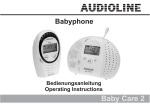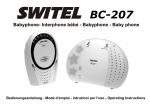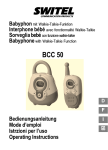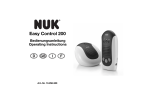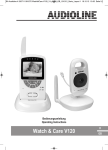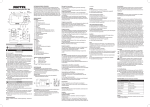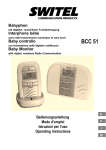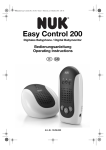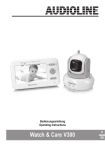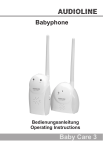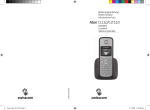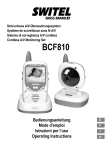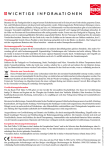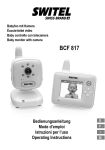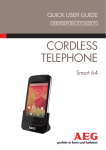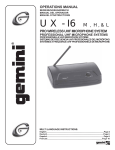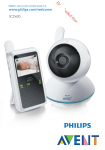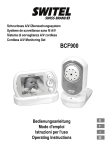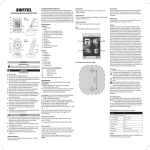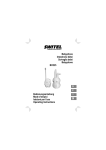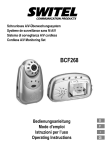Download BC-307
Transcript
BC-307 Babyphone- Interphone bébé - Babyphone - Baby phone Bedienungsanleitung - Mode d’emploi - Istruzioni per l'uso - Operating Instructions BC-307 Bedienungsanleitung ________________________________ 3 Mode d’emploi _____________________________________ 21 Istruzioni per l'uso _________________________________ 39 Operating Instructions ______________________________ 57 Declaration of Conformity ___________________________ 74 2 - Inhaltsverzeichnis 1 Allgemeine Sicherheitshinweise............................................................................................................................................. 4 2 Bedienelemente ........................................................................................................................................................................ 6 3 Inbetriebnahme......................................................................................................................................................................... 8 3.1 Elterneinheit............................................................................................................................................................................ 8 3.2 Babyeinheit............................................................................................................................................................................. 9 4 Bedienung ............................................................................................................................................................................... 10 4.1 Displayanzeigen und Ihre Bedeutung................................................................................................................................... 10 4.2 Aufstellort der Babyeinheit.................................................................................................................................................... 10 4.3 Ein-/Auschalten der Babyeinheit .......................................................................................................................................... 10 4.4 Ein-/Auschalten der Elterneinheit ......................................................................................................................................... 11 4.5 Lautstärken einstellen........................................................................................................................................................... 11 4.6 Übertragungsempfindlichkeit einstellen................................................................................................................................ 12 4.7 Schlaflieder abspielen .......................................................................................................................................................... 13 4.8 Gegensprechfunktion zum Baby .......................................................................................................................................... 14 4.9 Temperaturüberwachung ..................................................................................................................................................... 14 4.10 Warnton ein-/ausschalten..................................................................................................................................................... 16 4.11 Nachtlicht ein- ausschalten................................................................................................................................................... 16 4.12 Suchen der Elterneinheit ...................................................................................................................................................... 17 4.13 Überwachung des Funkkontaktes ........................................................................................................................................ 17 4.14 Auf Werkseinstellungen zurücksetzen.................................................................................................................................. 17 5 Wichtige Informationen.......................................................................................................................................................... 18 5.1 Fehlersuche.......................................................................................................................................................................... 18 5.2 Technische Daten................................................................................................................................................................. 19 3 - Allgemeine Sicherheitshinweise - 1 Allgemeine Sicherheitshinweise Mit dem BC-307 Babyphone haben Sie ein Qualitätsprodukt aus dem Hause SWITEL erworben. Bitte lesen Sie diese Bedienungsanleitung sorgfältig durch, um alle Möglichkeiten kennen zu lernen. Öffnen Sie das Gerät in keinem Fall selbst und führen Sie keine eigenen Reparaturversuche aus. Bei Gewährleistungsansprüchen wenden Sie sich bitte an Ihren Fachhändler. Zum Lieferumfang gehören eine Elterneinheit inklusive Gürtelclip eine Babyeinheit 2 wiederaufladbare Standard-Akkus für die Elterneinheit Ladestation für Elterneinheit inklusive Steckernetzteil Steckernetzteil für Babyeinheit eine Bedienungsanleitung Bestimmungsgemäße Verwendung Das Gerät ist für die Übertragung von Sprachsignalen, wie z.B. Kindergeräuschen entwickelt worden. Warn- oder Signaltöne von Atmungs- oder Herztonüberwachungsgeräten können NICHT übertragen werden. ACHTUNG: Die Verwendung des Gerätes kann die persönliche Beaufsichtigung eines Kindes oder einer anderen pflegebedürftigen Person NICHT ersetzen. Jede Haftung außerhalb der gesetzlichen Bestimmungen ist ausgeschlossen. Sicherheitshinweise • Das Gerät ist nicht für einen medizinischen Einsatz geeignet. • Verwenden Sie die Geräte mit einem Sicherheitsabstand von mindestens einem Meter. • Verwenden Sie nur hochwertige Batterien. • Verwenden Sie aus Sicherheitsgründen nur die mitgelieferten original Netzteile. Bei der Verwendung von nicht passenden Netzteilen können die Geräte in Brand geraten. • Achten Sie beim Betrieb mit einem Netzteil auf den einwandfreien Zustand der Kabel und Stecker. Abgeknickte oder durchgescheuerte Kabel können Kurzschlüsse erzeugen. Achtung! Brandgefahr. • Sorgen Sie während des Betriebs für eine ausreichende Belüftung aller Komponenten. Legen Sie keine Kissen oder Handtücher auf die Geräte. 4 • Verwenden Sie die Geräte nicht in explosionsgefährdeten Bereichen. • Die Geräte sind für den Betrieb in geschützten Räumen mit einem Temperaturbereich von 10 °C bis 30 °C ausgelegt. Die Geräte dürfen nicht in Feuchträumen wie Bad oder Waschküche aufgestellt werden. Vermeiden Sie die Nähe zu Wärmequellen wie Heizkörpern, und setzen Sie das Gerät keiner direkten Sonnenbestrahlung aus. • Ist die Gebrauchszeit der gesamten Anlage abgelaufen, entsorgen Sie diese bitte umweltfreundlich gemäß den gesetzlichen Bestimmungen. • Die max. Reichweite beträgt bis zu 300 Meter im Freien und bis zu 50 Meter innerhalb von Gebäuden. - Allgemeine Sicherheitshinweise Wiederaufladbare Standard-Akkus/Batterien • Verwenden Sie für die Babyeinheit als Stromausfallsicherung oder bei Batteriebetrieb nur hochwertige Batterien. • Verwenden Sie für die Elterneinheit nur Standard-Akkus des Typs AA 1,2V 1300mAh. • Wechseln Sie immer alle Standard-Akkus/Batterien gleichzeitig aus. • Standard-Akkus/Batterien nicht ins Feuer werfen oder ins Wasser tauchen. • Sollten Sie die Geräte über einen längeren Zeitraum nicht benutzen, entnehmen Sie bitte die Standard-Akkus/Batterien. Das längere Lagern mit eingebauten Standard-Akkus/Batterien kann zum Auslaufen der Standard-Akkus/Batterien führen. • Alte oder defekte Standard-Akkus/Batterien nicht mit dem normalen Hausmüll entsorgen. Sie sind gesetzlich verpflichtet alte Batterien und Akkus an geeigneten Sammelstellen zurückzugeben. Aufstellort Stellen Sie die Geräte nicht in die unmittelbare Umgebung von anderen elektronischen Geräten wie z. B. Mikrowellen oder HIFIGeräten, da es sonst zu gegenseitiger Beeinflussung kommen kann. Der Aufstellort hat einen entscheidenden Einfluss auf einen einwandfreien Betrieb. Stellen Sie die Geräte auf eine ebene und rutschfeste Fläche. Normalerweise hinterlassen die Füße keine Spuren auf der Aufstellfläche. Wegen der Vielzahl der verwendeten Lacke und Oberflächen kann es jedoch nicht ausgeschlossen werden, dass durch die Gerätefüße Spuren auf der Abstellfläche entstehen. Reinigung und Pflege Die Gehäuseoberflächen können mit einem trockenen, weichen und fusselfreien Tuch gereinigt werden. Niemals Reinigungsmittel oder gar aggressive Lösungsmittel verwenden. Außer einer gelegentlichen Gehäusereinigung ist keine weitere Pflege erforderlich. Die Gummifüße des Babyphones sind nicht gegen alle Reinigungsmittel beständig. Der Hersteller kann daher nicht für evtl. Schäden an Möbeln o. ä. haftbar gemacht werden. 5 - Bedienelemente - 2 Bedienelemente 1 2 3 4 Babyeinheit 1 2 3 4 5 6 7 8 9 10 11 Nachtlicht Ein-/Ausschalten Temperaturfühler Suchen der Elterneinheit mit der Paging-Taste Lautstärke einstellen Beleuchtetes Display Start/Stopp zum Abspielen der Wiegenlieder Pause-Taste beim Abspielen der Wiegenlieder Mikrofon Ein-/Ausschalten Zum Auswählen der Wiegenlieder Optische Anzeige, ob eine Verbindung zur Elterneinheit besteht Rückseite 12 Batteriefach 13 Anschluss Steckernetzteil 11 5 12 10 9 13 6 8 6 7 - Bedienelemente Elterneinheit 14 15 16 17 18 19 20 21 Taste für die Gegensprechfunktion zur Babyeinheit Ein-/Ausschalten Beleuchtetes Display Bestätigungstaste bei Menüfunktionen Optische Anzeige, ob eine Verbindung zur Babyeinheit besteht Taste Menü Lautstärke einstellen/Auswahl von Menüfunktionen Visuelle Anzeige der Babyüberwachung 21 20 19 18 14 15 16 17 Rückseite 22 Gürtelclip 23 Batteriefach Ladestation für die Elterneinheit 24 Ladekontrollleuchte, leuchtet beim Laden der Elterneinheit 22 24 23 7 - Inbetriebnahme - 3 3.1 Inbetriebnahme Elterneinheit Standard-Akkus einbauen Öffnen Sie das Batteriefach an der Elterneinheit, indem Sie den Batteriefachdeckel am unteren Ende nach oben schieben. Ist der Gürtelclip angebracht, muss dieser zuerst entfernt werden. Legen Sie nun die Standard-Akkus ein und achten Sie auf die richtige Polung. Schließen Sie den Batteriefachdeckel. ACHTUNG: Verwenden Sie keine normalen, nicht wiederaufladbaren Batterien in der Elterneinheit. Verwenden Sie die Elterneinheit niemals ohne Standard-Akkus auf der Ladestation. Gürtelclip anbringen oder entfernen Um den Gürtelclip anzubringen, stecken Sie das obere Ende in die Elterneinheit und drücken Sie dann den Gürtelclip nach unten. Soll der Gürtelclip entfernt werden, drücken Sie mit einem Schraubenzieher auf die Halterung im Innern des Gürtelclips und ziehen den Gürtelclip nach oben. Clip anbringen Clip entfernen Anschließen der Ladestation Das Steckernetzteil ist fest mit der Ladestation verbunden. Stecken Sie das Steckernetzteil in eine vorschriftsmäßig installierte Netzsteckdose mit 230V. 8 - Inbetriebnahme Laden der Elterneinheit Stellen Sie die Elterneinheit mit dem Display nach vorne für mindestens 16 Stunden auf die Ladestation. An der Ladestation leuchtet die Ladekontrollleuchte und im Display wird das Laden durch eine laufende Anzeige des Batteriesymbols signalisiert. Ist die Elterneinheit voll aufgeladen, zeigt das Display ein vollständiges Batteriesymbol im Display. Die wiederaufladbaren StandardAkkus besitzen eine Betriebszeit bei Zimmertemperatur von max. 12 bis 24 Stunden. Die aktuelle Batteriekapazität wird im Display angezeigt: Voll Halb Schwach Ist die Batteriekapazität zu gering, erscheint im Display eine entsprechende Meldung und Sie hören jede Minute einen Warnton. Nach dem ersten Warnton ist die Elterneinheit noch für 1 Stunde zu benutzen. 3.2 Babyeinheit Netzteil anschließen Verwenden Sie das mitgelieferte Steckernetzteil für die Babyeinheit. Stecken Sie den kleinen runden Stecker in die vorgesehene Buchse (13) auf der Rückseite der Babyeinheit an und das Netzteil in eine Steckdose (230V/50Hz). Achten Sie auf eine ausreichende Belüftung des Steckernetzteils. Batterien zur Stromausfallsicherung oder Batteriebetrieb einbauen (nicht im Lieferumfang) Die Babyeinheit ist zum Betrieb mit dem mitgelieferten Steckernetzteil ausgelegt. Als Stromausfallsicherung oder kurzzeitigen Batteriebetrieb kann die Babyeinheit mit vier 1.5V AA Alkaline Batterien betrieben werden. Die Babyeinheit ist in diesem Fall mit neuen Batterien für 16 Stunden betriebsbereit und im Display erscheint die Meldung BATTERIE. Ist die Batteriekapazität zu gering, erscheint im Display eine entsprechende Meldung und Sie hören jede Minute einen Warnton. Nach dem ersten Warnton ist die Babyeinheit noch für 1 Stunde zu benutzen. Öffnen Sie das Batteriefach auf der Rückseite mit einer Münze und setzen Sie die Batterien ein. Achten Sie dabei auf die richtige Polung und schließen Sie das Batteriefach. 9 - Bedienung - 4 Bedienung 4.1 Displayanzeigen und Ihre Bedeutung 1. 2. 3. 4. 5. Kapazität der Batterie Anzeige der aktuellen Temperatur Nachtlicht ist eingeschaltet Es wird ein Schlaflied abgespielt Unterschiedliche Menüanzeigen 4.2 Aufstellort der Babyeinheit 1 2 3 Lullaby1 4 5 Plazieren Sie die Babyeinheit in der Nähe des Babys. Beachten Sie den Mindestabstand von einem Meter. Für eine optimale Übertragung sollte das eingebaute Mikrofon (8) in Richtung des Kindes zeigen. Beachten Sie die weiteren Sicherheitshinweise im Kapitel 1 dieser Bedienungsanleitung. Hinweis: Bitte verwenden Sie die Elterneinheit nicht zu nah an der Babyeinheit, da es ansonsten zu lauten Pfeifgeräuschen kommen kann. Entfernen Sie sich in diesem Fall von der Babyeinheit oder reduzieren Sie die Lautstärke. 4.3 Ein-/Auschalten der Babyeinheit Sie schalten die Babyeinheit ein, indem Sie die Ein/Aus-Taste (9) für eine Sekunde drücken. Nun wird die Elterneinheit gesucht und nach einigen Sekunden leuchtet die Anzeige (11) grün. Sollte die Babyeinheit die Elterneinheit nicht finden, blinkt die Anzeige (11) rot. Möchten Sie die Babyeinheit ausschalten, halten Sie die Ein/Aus-Taste (9) für eine Sekunde gedrückt. 10 - Bedienung 4.4 Ein-/Auschalten der Elterneinheit Sie schalten die Elterneinheit ein, indem Sie die Ein/Aus-Taste (15) für eine Sekunde drücken. Nun wird die Babyeinheit gesucht und nach einigen Sekunden leuchtet die Anzeige (18) grün. Sollte die Babyeinheit die Elterneinheit nicht finden, blinkt die Anzeige (18) rot. Möchten Sie die Elterneinheit ausschalten, halten Sie die Ein/Aus-Taste (15) für eine Sekunde gedrückt. Hinweis: Die Elterneinheit kann auch benutzt werden, wenn die Elterneinheit auf der Ladestation steht. Die Standard-Akkus werden hierbei weiterhin geladen, jedoch dauert das vollständige Laden länger. 4.5 Lautstärken einstellen Babyeinheit Die Lautstärke an der Babyeinheit kann in fünf Stufen über die Tasten und (4) eingestellt werden. Die eingestellte Lautstärke betrifft das Abspielen der Schlaflieder und gleichzeitig die Lautstärke für die Gegensprechfunktion. Siehe dazu Kapitel 4.8. Elterneinheit Die Lautstärke an der Elterneinheit lässt sich in fünf Stufen mit den Tasten Lautsprecher auch ganz abgeschaltet werden (VOLUME OFF). und (20) einstellen. Zusätzlich kann der Neben der akustischen Übertragung über den Lautsprecher, werden die Geräusche auch visuell über fünf grüne und drei rote Anzeigen (21) dargestellt. So können Sie auch bei reduzierter oder ganz abgeschalteter Lautstärke eine Überwachung vornehmen. Hinweise: • Ist die Lautstärke an der Elterneinheit ausgeschaltet, kann Sie auch ein Warnton auf Geräusche des Babys hinweisen. Siehe dazu Kapitel 4.10. • Die Lautstärke an der Elterneinheit wird automatisch wieder auf eine mittlere Lautstärke gesetzt, wenn die Gegensprechfunktion benutzt wird und die Lautstärke vorher abgeschaltet war. 11 - Bedienung 4.6 Übertragungsempfindlichkeit einstellen Die Übertragungsempfindlichkeit von der Babyeinheit zur Elterneinheit kann in 5 Stufen eingestellt werden. Bei der Stufe 5 sind auch sehr leise Geräusche an der Elterneinheit zu hören. Bei der Stufe 1 sind nur laute Geräusche hörbar. Möchten Sie sicher sein, dass Sie alle Geräusche hören, verwenden Sie die Stufe 5. Hinweis: Diese Einstellung hat keinen Einfluss auf die visuelle Anzeige der Geräusche an der Elterneinheit. 1. Taste MENÜ (19) drücken. 2. Wählen Sie mit der Taste (20) den Menüpunkt SENSITIVITY. 3. Drücken Sie einmal die Taste 4. Wählen Sie nun mit den Tasten 5. 6. Bestätigen Sie mit der Taste (17). Das Display zeigt kurz SAVED und dann den Menüpunkt SENSITIVITY. Drücken Sie die Taste MENÜ, um die Programmierung zu verlassen. 12 (17). Das Display zeigt die aktuell eingestellte Empfindlichkeit in 5 Stufen an. und (20) die gewünschte Empfindlichkeit. - Bedienung 4.7 Schlaflieder abspielen Damit Ihr Baby ruhig einschlafen kann, sind fünf Schlaflieder mit einer jeweiligen Länge von 30 Sekunden gespeichert. Die Spielzeit beträgt mit mehreren Wiederholungen ca. 5 Minuten. Das Abspielen der Schlaflieder kann über die Babyeinheit und auch über die Elterneinheit erfolgen. Schlaflieder an der Babyeinheit bedienen Durch mehrmaliges Drücken der Taste (10) können Sie das gewünschte SCHLAFLIED 1 bis 5 oder ALLE SPIELEN aussuchen. Bei der Einstellung ALLE SPIELEN werden alle Schlaflieder für 5 Minuten nacheinander abgespielt. Durch drücken der Taste (6) können Sie das Abspielen starten und stoppen. Mit der Taste Abspielen unterbrechen, um dann der gleichen Taste (7) können Sie das (7) fortzufahren. Schlaflieder an der Elterneinheit bedienen 1. Drücken Sie die Taste MENÜ (19). 2. Wählen Sie mit der 3. Bestätigen Sie mit der Taste 4. (20) den Menüpunkt LULLABY. Drücken Sie erneut die Taste (17). Das Display zeigt PLAY?. (17), und das zuletzt abgespielte Schlaflied wird erneut abgespielt. Möchten Sie ein anderes Schlaflied aussuchen, drücken Sie vorher die Taste (20). Im Display erscheint SELECT NEW. 5. Bestätigen Sie mit der Taste 6. Wählen Sie nun mit den Tasten 7. Bestätigen Sie mit der Taste (17) und das gewählte Schlaflied wird abgespielt. Bei der Einstellung PLAY ALL werden alle Schlaflieder für 5 Minuten nacheinander abgespielt. 8. 9. Die Taste (17) kann während des Abspielens als PAUSE-Taste benutzt werden. Um das Abspielen zu stoppen, drücken Sie die Taste MENÜ (19). Das Display zeigt STOP LULLABY?. 10. Bestätigen Sie mit der Taste (17). und (20) das gewünschte Schlaflied aus. Oder wählen Sie PLAY ALL. (17) und das Abspielen wird gestoppt. 13 - Bedienung Hinweise: • Während des Abspielens der Schlaflieder, erscheint im Display der Babyeinheit und auch der Elterneinheit die Anzeige und der Name des gerade gespielten Schlafliedes. So können Sie von der Elterneinheit überwachen, ob gerade ein Schlaflied abgespielt wird. • • • Wird das Abspielen auf Pause geschaltet, blinkt in beiden Displays die Anzeige . Die Pause darf nicht länger als 60 Sekunden betragen. Danach wird das Abspielen der Schlaflieder automatisch gestoppt. Sie können das komplette Menü an der Elterneinheit auch während des Abspielens von Schlafliedern komplett nutzen. 4.8 Gegensprechfunktion zum Baby Um das Baby zu beruhigen, können Sie mit der Gegensprechfunktion zum Baby sprechen. Halten Sie dazu die Taste TALK (14) an der Elterneinheit gedrückt, und sprechen Sie. Nach dem Loslassen der Taste TALK (14) können Sie wieder das Baby hören. Während Sie sprechen, blinkt an der Eltern- und Babyeinheit jeweils die Kontrollleuchte (11/18). Hinweis: Ist die Lautstärke an der Elterneinheit ausgeschaltet, wird diese automatisch wieder auf eine mittlere Lautstärke gesetzt. 4.9 Temperaturüberwachung Die Temperatur im Kinderzimmer wird auf beiden Displays permanent angezeigt. Achten Sie darauf, dass der Temperaturfühler nicht von irgendwelchen Gegenständen bedeckt ist. Zusätzlich kann ein einstellbarer Temperaturbereich überwacht werden. Sollte dieser Bereich unter- oder überschritten werden, hören Sie an der Elterneinheit bei jeder Über- oder Unterschreitung einen kurzen Signalton, und im Display blinkt die Temperaturanzeige. Steigt oder sinkt die Temperatur weiter, hören Sie bei jeder Veränderung diesen kurzen Signalton. Hinweis: Normalerweise ertönt der Signalton bei jedem Grad einer weiteren Unter- oder Überschreitung des eingestellten Temperaturbereichs. Durch das Drücken einer beliebigen Taste an der Elterneinheit können Sie den Bereich um 2°C Grad nach oben oder unten verlegen, sodass erst bei der übernächsten Über- oder Unterschreitung ein Signalton ertönt. 14 - Bedienung Temperaturbereich einstellen 1. Taste MENÜ (19) drücken. 2. Wählen Sie mit der Taste 3. Drücken Sie zweimal die Taste (20) den Menüpunkt TEMPERATURE. 4. Wählen Sie nun die gewünschte Minimum-Temperatur mit den Tasten 5. Bestätigen Sie mit der Taste Temperatur. 6. Wählen Sie nun die gewünschte Maximum-Temperatur mit den Tasten 7. 8. Bestätigen Sie mit der Taste (17). Das Display zeigt kurz SAVED und dann den Menüpunkt TEMPERATURE. Drücken Sie die Taste MENÜ, um die Programmierung zu verlassen. (17). Das Display zeigt die aktuell eingestellte Minimum-Temperatur. und (20). Einstellbereich 10 bis 19°C. (17). Das Display zeigt kurz SAVED und dann die aktuell eingestellte Maximumund (20). Einstellbereich 22 bis 30°C. Temperaturüberwachung ein-/ausschalten 1. Taste MENÜ (19) drücken. 2. Wählen Sie mit der Taste 3. Drücken Sie einmal die Taste (20) den Menüpunkt TEMPERATURE. 4. Wählen Sie nun mit den Tasten 5. Bestätigen Sie mit der Taste (17). Ist die Überwachung ausgeschaltet, zeigt das Display ALERT ON?. Bei ausgeschalteter Überwachung zeigt das Display ALERT OFF?. 6. 7. Bestätigen Sie mit der Taste (17). Das Display zeigt kurz SAVED und dann den Menüpunkt TEMPERATURE. Drücken Sie die Taste MENÜ (19), um die Programmierung zu verlassen. (17). Das Display zeigt den Menüpunkt RANGE. und (20) den Menüpunkt ALERT ON/OFF. 15 - Bedienung 4.10 Warnton ein-/ausschalten Ist die Lautstärke an der Elterneinheit ausgeschaltet, kann Sie auch ein Warnton auf Geräusche des Babys hinweisen. Ist die zweitletzte Stufe der visuellen Anzeige erreicht, ertönt der Warnton und im Display erscheint die Anzeige SOUND ALERT. Erhöhen Sie dann die Lautstärke, um Ihr Baby zu hören. Hinweis: Bei eingeschalteter Lautstärke ist der Hinweiston automatisch ausgeschaltet. 1. Taste MENÜ (19) drücken. 2. Wählen Sie mit der Taste 3. Bestätigen Sie mit der Taste (17). Ist der Hinweiston ausgeschaltet, zeigt das Display ALERT ON?. Bei ausgeschaltetem Hinweiston zeigt das Display ALERT OFF?. 4. 5. Bestätigen Sie mit der Taste (17). Das Display zeigt kurz SAVED und dann den Menüpunkt SOUND ALERT. Drücken Sie die Taste MENÜ (19), um die Programmierung zu verlassen. 4.11 (20) den Menüpunkt SOUND ALERT. Nachtlicht ein- ausschalten Mit der Taste (1) können Sie das Nachtlicht an der Babyeinheit ein- und ausschalten. Bei eingeschaltetem Nachtlicht erscheint in beiden Displays die Anzeige . So können Sie auch über die Elterneinheit kontrollieren, ob das Nachtlicht ein- oder ausgeschaltet ist. Das Nachtlicht kann zusätzlich auch über die Elterneinheit geschaltet werden. Nachtlicht über das Elternteil einschalten 1. Taste MENÜ (19) drücken. 2. Ist das Nachtlicht ausgeschaltet, erscheint im Display LIGHT ON?. 3. Bestätigen Sie mit (17). Das Nachtlicht ist eingeschaltet und im Display erscheint die Anzeige . Nachtlicht über das Elternteil ausschalten 1. Taste MENÜ (19) drücken. 2. Ist das Nachtlicht eingeschaltet, erscheint im Display LIGHT OFF?. 3. 16 Bestätigen Sie mit (17). Das Nachtlicht ist ausgeschaltet und im Display erscheint die Anzeige . - Bedienung 4.12 Suchen der Elterneinheit Wenn Sie sich nicht mehr erinnern können, wo Sie die Elterneinheit liegen gelassen haben, drücken Sie die Taste PAGE (3) der Babyeinheit. Sie werden für 2 Minuten die Rufsignale der Elterneinheit hören und es so leicht wiederfinden. Mit einer beliebigen Taste am Eltern- oder Mobilteil können Sie die Tonsignale vorher beenden. Hinweis: Ist die Lautstärke an der Elterneinheit ausgeschaltet, wird diese automatisch wieder auf eine mittlere Lautstärke gesetzt. 4.13 Überwachung des Funkkontaktes Der Funkkontakt zwischen der Elterneinheit und der Babyeinheit wird ständig überwacht. Bei einer guten Verbindung leuchtet an der Eltern- und Babyeinheit die grüne Kontrollleuchte LINK (18/11). Haben Sie sich mit der Elterneinheit zu weit von der Babyeinheit entfernt oder ist die Babyeinheit ausgeschaltet, blinkt die grüne Kontrollleuchte und Sie hören alle 30 Sekunden einen Warnton. Danach blinkt die Kontrollleuchte in roter Farbe, es erscheint die Displaymeldung NOT LINKED und Sie hören alle 30 Sekunden einen Warnton. Hinweis: Der Warnton beim Abbrechen des Funkkontaktes kann nicht abgeschaltet werden. Durch das Drücken einer beliebigen Taste an der Elterneinheit lässt sich der Warnton jedoch für 3 Minuten abschalten. 4.14 Auf Werkseinstellungen zurücksetzen Die Werkseinstellungen können individuell an der Eltern- und Babyeinheit zurückgesetzt werden. Schalten Sie die Eltern- oder Babyeinheit ein. Während alle Anzeigen leuchten, halten Sie sofort die Lautstärketaste erscheint. Nach einigen Sekunden ist der Reset durchgeführt. Werkseinstellungen Babyeinheit Lautstärke: Stufe 3 Wiegenlied: 1 Temperaturüberwachung: Minimum 14°C, Maximum 23°C (4/20) gedrückt, bis im Display die Anzeige RESET Werkseinstellungen Elterneinheit Lautstärke: Stufe 1 Empfindlichkeit: Stufe 5 Warnton: Ein Temperaturüberwachung: Aus 17 - Wichtige Informationen - 5 5.1 Wichtige Informationen Fehlersuche Haben Sie Probleme mit Ihrem Produkt, kontrollieren Sie bitte zuerst die folgenden Hinweise. Bei Garantieansprüchen wenden Sie sich bitte an Ihren Fachhändler. Die Garantiezeit beträgt 2 Jahre. Für die wiederaufladbaren Batterien gilt eine Garantiezeit von 12 Monaten. Problem Kontrollleuchte (18/11) blinkt rot. Pfeifton Keine Übertragung Mögliche Ursache Elterneinheit oder Babyeinheit sind nicht eingeschaltet. Der Abstand zwischen dem Eltern- und Babyeinheit ist zu gering. Die Lautstärke ist zu hoch. Die Lautstärke an der Elterneinheit ist zu gering. Die Empfindlichkeit ist zu niedrig eingestellt. Die Reichweite ist überschritten. Elterneinheit lässt sich nicht einschalten. Elterneinheit ist nicht geladen. Akkus der Elterneinheit werden nicht geladen. Anzeige LOW BATTERY an der Babyeinheit. Die Standard-Akkus haben das Ende ihrer Lebensdauer erreicht. Die Batterien in der Babyeinheit sind verbraucht. 18 Abhilfe Einschalttaste drücken. Entfernen Sie sich mit der Elterneinheit von der Babyeinheit. Verringern Sie die Lautstärke. Die Lautstärke der Elterneinheit erhöhen. Empfindlichkeit über die Elterneinheit erhöhen. Gehen Sie mit der Elterneinheit näher zur Babyeinheit. Laden Sie die Elterneinheit auf der Ladestation. Standard-Akkus austauschen. Batterien in der Babyeinheit austauschen. - Wichtige Informationen 5.2 Technische Daten Standard Kanalzahl Reichweite Reichweite Standby Elterneinheit Stromversorgung Elterneinheit Stromversorgung Ladestation Elterneinheit Stromversorgung Babyeinheit Stromausfallsicherung Babyeinheit Standby Babyeinheit bei Batteriebetrieb Zulässige Umgebungstemperatur Zulässige relative Luftfeuchtigkeit DECT 120 Kanäle zwischen 1880 bis 1990 MHz Innen bis zu 50m Außen bis zu 300m ca. 12 bis 24 Stunden 2 x AA 1,2V 1300mAh Standard-Akkus Steckernetzteil DC 9.0V/300mA fest mit der Ladestation verbunden Steckernetzteil DC 9.0V/300mA 4 x 1.5V AA Alkaline Batterien bis zu 16 Stunden 10°C bis 30°C 20 bis 75% 19 20 - Sommaire 1 Consignes générales de sécurité ..................................................................................................................................... 22 2 Éléments de commande .................................................................................................................................................... 24 3 Mise en service ................................................................................................................................................................... 26 3.1 Module parents............................................................................................................................................................. 26 3.2 Module bébé................................................................................................................................................................. 27 4 Utilisation ............................................................................................................................................................................ 28 4.1 Affichages d’écran et leur signification ......................................................................................................................... 28 4.2 Lieu d’installation du module bébé ............................................................................................................................... 28 4.3 Mise en marche/arrêt du module bébé......................................................................................................................... 28 4.4 Mise en marche/arrêt du module parents..................................................................................................................... 29 4.5 Régler le volume........................................................................................................................................................... 29 4.6 Régler la sensibilité de transmission ............................................................................................................................ 30 4.7 Déclencher les berceuses ............................................................................................................................................ 31 4.8 Fonction interphone avec le bébé ................................................................................................................................ 32 4.9 Surveillance de la température..................................................................................................................................... 32 4.10 Activer/désactiver le signal d’avertissement................................................................................................................. 34 4.11 Activation/désactivation de la veilleuse ........................................................................................................................ 34 4.12 Chercher le module parents ......................................................................................................................................... 35 4.13 Surveillance du contact radio ....................................................................................................................................... 35 4.14 Restaurer les réglages par défaut ................................................................................................................................ 35 5 Informations importantes .................................................................................................................................................. 36 5.1 Recherche de défauts .................................................................................................................................................. 36 5.2 Caractéristiques techniques ......................................................................................................................................... 37 21 - Consignes générales de sécurité - 1 Consignes générales de sécurité En achetant l’interphone bébé BC-307 , vous avez acquis un produit de qualité de la société SWITEL. Veuillez lire attentivement en entier le présent mode d’emploi afin de découvrir toutes les possibilités offertes par votre appareil. N’ouvrez en aucun cas l’appareil vous-même et ne tentez pas d’effectuer vous-même des réparations. Veuillez vous adresser à votre revendeur en cas de droits découlant de la garantie. Le contenu de l’emballage un module parents avec clip-ceinture un module bébé 2 batteries standard rechargeables pour le module parents chargeur pour le module parents avec bloc d’alimentation bloc d’alimentation pour le module bébé un mode d’emploi Usage conforme L’appareil est conçu pour la transmission de signaux vocaux tels que, par exemple, des bruits effectués par un enfant. Les sons d’avertissement ou les signaux sonores d’appareils de surveillance de la respiration ou des battements du cœur ne peuvent PAS être transmis. ATTENTION : L’utilisation de l’appareil ne peut PAS se substituer à une surveillance en personne d’un enfant ou d’une personne nécessitant des soins. Toute responsabilité en dehors des prescriptions légales est exclue. Consignes de sécurité • L’appareil ne convient pas pour une utilisation médicale. • Utilisez les appareils en respectant une distance de sécurité d’au moins un mètre. • Utilisez uniquement des piles de bonne qualité. • Par sécurité, utilisez uniquement les blocs d’alimentation originaux fournis. Les appareils risqueraient de prendre feu si vous utilisez des blocs d’alimentation inadéquats. • Lorsque vous faites fonctionner l’appareil avec un bloc d’alimentation, veillez à ce que le câble et la fiche soient en parfait état. Les câbles rompus en pliant ou usés peuvent provoquer des courts-circuits. Attention ! Risque d’incendie. • Durant le fonctionnement, veillez à assurer une aération suffisante de tous les composants. Ne placez pas de coussins ou de serviettes sur les appareils. 22 • N’utilisez pas les appareils dans des zones menacées d’explosion. • Les appareils sont conçus pour une utilisation dans des locaux abrités avec une plage de températures comprise entre 10°C et 30°C. Les appareils ne doivent pas être installés dans des pièces humides telles que la salle de bains ou la buanderie. Évitez de placer l’appareil à proximité de sources de chaleur telles que les radiateurs et évitez une exposition directe au soleil. • Lorsque l’installation entière arrive en fin de vie, veuillez l’éliminer en respectant l’environnement conformément aux dispositions légales. • La portée max. peut atteindre jusqu’à 300 mètres à l’extérieur et jusqu’à 50 m à l’intérieur de bâtiments. - Consignes générales de sécurité Batteries standards rechargeables/piles • Utilisez pour le module bébé uniquement des piles de bonne qualité comme sécurité en cas de panne de courant et pour un fonctionnement sur piles. • Pour le module parents, utilisez uniquement des batteries standard de type AA 1,2V 1300mAh. • Changez toujours toutes les batteries standard/piles en même temps. • Ne pas jeter les batteries standard/piles au feu, ni les plonger dans l’eau. • Veuillez retirer les batteries standard/piles des appareils si vous ne les utilisez pas durant une période prolongée. Les batteries standards/piles risquent de couler si vous les laissez en place longtemps dans l’appareil. • Ne pas jeter les batteries standard/piles usées ou défectueuses en même temps que les ordures ménagères normales. Vous êtes tenu par la loi de déposer les piles et les batteries usées dans des endroits de collecte appropriés. Lieu d’installation N’installez pas les appareils à proximité directe d’autres appareils électroniques tels que par ex. les fours à micro-ondes ou les chaînes hi-fi car cela pourrait provoquer des perturbations mutuelles. Le lieu d’installation a une grande influence sur le parfait fonctionnement. Placez les appareils sur une surface plane et antidérapante. Normalement, les pieds ne marquent pas la surface sur laquelle l’appareil est posé. La multitude de vernis et de surfaces utilisés ne permet cependant pas d’exclure l’éventualité de traces laissées par les pieds de l’appareil sur la surface sur laquelle il est posé. Nettoyage et entretien Vous pouvez utiliser un chiffon sec, doux et non-pelucheux pour nettoyer les surfaces du boîtier. Ne jamais utiliser de produits nettoyants ou de solvants agressifs. Aucun entretien n’est nécessaire hormis le nettoyage du boîtier de temps en temps. Les pieds en caoutchouc de l’interphone bébé ne sont pas résistants à tous les produits nettoyants. Par conséquent, le fabricant ne peut pas être tenu responsable d’éventuelles détériorations survenant aux meubles ou autres. 23 - Éléments de commande - 2 Éléments de commande 1 2 3 4 Module bébé 1 2 3 4 5 6 7 8 9 10 11 Activation/désactivation de la veilleuse Capteur de température Recherche du module parents avec la touche Paging Régler le volume Écran d’affichage éclairé Activation/désactivation des berceuses Touche pause lors de l’écoute de berceuses Micro Mise en marche/arrêt Pour sélectionner les berceuses Signalisation visuelle indiquant si une liaison existe avec le module parents Face arrière 12 Compartiment des piles 13 Raccordement du bloc d’alimentation 11 5 12 10 9 13 24 8 6 7 - Éléments de commande Module parents 14 15 16 17 18 19 20 21 Touche de la fonction interphone avec le module bébé Mise en marche/arrêt Écran d’affichage éclairé Touche de validation pour les fonctions de menu Signalisation visuelle indiquant si une liaison existe avec le module bébé Touche menu Réglage du volume/sélection des fonctions de menu Signalisation visuelle de la surveillance du bébé 21 20 19 18 14 15 16 17 Face arrière 22 Clip ceinture 23 Compartiment des piles Chargeur du module parents 24 Voyant de contrôle de charge allumé lorsque le module parents se charge 22 24 23 25 - Mise en service - 3 3.1 Mise en service Module parents Mettre les batteries standard en place Ouvrez le compartiment des piles sur le module parents en exerçant une légère pression sur l’extrémité inférieure du couvercle tout en le faisant coulisser vers le haut. Vous devez d’abord enlever le clip-ceinture s’il est déjà fixé. Mettez ensuite les batteries standard sur le chargeur en place en respectant la polarité adéquate. Refermez le compartiment des piles. ATTENTION : N’utilisez pas de piles normales non rechargeables dans le module parents. N’utilisez jamais le module parents sans batteries standard sur le chargeur. Installer ou enlever le clip-ceinture Pour installer le clip-ceinture, enfoncez l’extrémité supérieure dans le module parents et pressez ensuite le clip-ceinture vers le bas. Si vous devez l’enlever, appuyez à l’aide d’un tournevis sur le support à l’intérieur du clip-ceinture et tirez le clip-ceinture vers le haut. Installer le clip Retirer le clip Raccordement du chargeur Le bloc d’alimentation est relié fixement au chargeur. Enfoncez le bloc d’alimentation dans une prise de courant de 230 V installée conformément aux dispositions réglementaires. 26 - Mise en service Charge du module parents Laissez le module parents en place sur le chargeur avec l’écran tourné vers l’avant durant au moins 16 heures. Le voyant de contrôle de charge est allumé sur le chargeur et le processus de charge est signalé sur l’écran par un affichage continu de l’icône de pile. Si le module parents est entièrement chargé, l’écran affiche une icône de pile entièrement chargée. Les batteries standard rechargeables ont une durée de fonctionnement à température ambiante de max. 12 à 24 heures. La capacité de pile actuelle est affichée à l’écran : Pleine Moitié Faible Si la capacité des piles est trop faible, l’écran affiche un message correspondant et un signal sonore retentit toutes les minutes. Après le premier signal sonore, le module parents peut encore être utilisé durant 1 heure. 3.2 Module bébé Raccorder le bloc d’alimentation Utilisez le bloc d’alimentation fourni pour le module bébé. Branchez la petite fiche ronde dans la prise (13) prévue à cet effet sur la face arrière du module bébé et le bloc d’alimentation dans une prise de courant (230V/50Hz). Veillez à assurer une aération suffisante du bloc d’alimentation. Mettre en place des piles comme sécurité en cas de panne de courant ou pour un fonctionnement sur piles (Non fournies) Le module bébé est conçu pour fonctionner avec le bloc d’alimentation fourni. Le module bébé peut être utilisé avec quatre piles alcalines AA de 1,5V en guise de sécurité contre les pannes de courant ou pour un bref fonctionnement sur piles. Le module bébé est dans ce cas opérationnel avec des piles neuves pour une durée de 16 heures et le message PILE s’affiche à l’écran. Si la capacité des piles est trop faible, l’écran affiche un message correspondant et un signal sonore retentit toutes les minutes. Après le premier signal sonore, le module bébé peut encore être utilisé durant 1 heure. Ouvrez le compartiment des piles situé sur la face arrière à l’aide d’une pièce de monnaie et mettez les piles en place en respectant la polarité adéquate, puis refermez le compartiment des piles. 27 - Utilisation - 4 Utilisation 4.1 Affichages d’écran et leur signification 1. 2. 3. 4. 5. Capacité de la pile Affichage de la température actuelle Veilleuse activée Une berceuse est activée Divers affichages de menu 4.2 Lieu d’installation du module bébé 1 2 3 Lullaby1 4 5 Placez le module bébé à proximité du bébé en respectant une distance minimale d’un mètre. Afin d’obtenir une transmission optimale, le micro intégré (8) doit être dirigé vers l’enfant. Tenez compte des autres consignes de sécurité du chapitre 1 du présent mode d’emploi. Remarque : N’utilisez pas le module parents à une trop grande proximité du module bébé car cela risque de provoquer de forts sifflements. Dans ce cas, éloignez-vous du module bébé ou baissez le volume. 4.3 Mise en marche/arrêt du module bébé Mettez le module bébé en marche en appuyant sur la touche marche/arrêt (9) durant une seconde. Le module parents est à présent recherché et au bout de quelques secondes la signalisation (11) s’allume en vert. Si le module bébé ne trouve pas le module parents, la signalisation (11) clignote en rouge. Si vous souhaitez désactiver le module bébé, appuyez sur la touche marche/arrêt (9) durant une seconde. 28 4.4 - Utilisation Mise en marche/arrêt du module parents Mettez le module parents en marche en appuyant sur la touche marche/arrêt (15) durant une seconde. Le module bébé est à présent recherché et au bout de quelques secondes la signalisation (18) s’allume en vert. Si le module bébé ne trouve pas le module parents, la signalisation (18) clignote en rouge. Si vous souhaitez désactiver le module parents, appuyez sur la touche marche/arrêt (15) durant une seconde. Remarque : Le module parents peut aussi être utilisé lorsqu’il est posé sur le chargeur. Les batteries standard continuent à se charger, mais elles mettront plus de temps à se charger intégralement. 4.5 Régler le volume Module bébé Le volume sur le module bébé peut être réglé sur cinq niveaux à l’aide des touches berceuses et en même temps la fonction interphone. Voir à cet effet le chapitre 4.8. et (4). Le volume réglé concerne les Module parents Le volume sur le module parents peut être réglé sur cinq niveaux à l’aide des touches peut être entièrement désactivé (VOLUME OFF). et (20). En plus, le haut-parleur Outre la transmission sonore par le haut-parleur, les bruits sont également indiqués visuellement par cinq signalisations vertes et trois rouges (21). Vous pouvez ainsi opérer une surveillance également lorsque le volume est baissé ou entièrement désactivé. Remarques : • Si le volume sur le module parents est désactivé, un signal d’avertissement peut également vous signaler les bruits du bébé. Voir à cet effet le chapitre 4.10. • Le volume sur le module parents se règle automatiquement à nouveau sur un volume moyen lorsque la fonction d’interphone est utilisée et que le volume était auparavant désactivé. 29 - Utilisation 4.6 Régler la sensibilité de transmission La sensibilité de transmission du module bébé vers le module parents peut être réglée sur 5 niveaux. Sur le niveau 5, les bruits même très faibles peuvent être entendus sur le module parents. Seuls des bruits forts sont audibles sur le niveau 1. Si vous souhaitez être sûr d’entendre tous les bruits, utilisez le niveau 5. Remarque : Ce réglage n’a pas d’influence sur la signalisation visuelle des bruits sur le module parents. 1. Appuyez sur la touche MENU (19). 2. Sélectionnez à l’aide de la touche 3. Appuyez sur la touche 4. Sélectionnez à présent la sensibilité souhaitée à l’aide des touches 5. 6. Validez à l’aide de la touche (17). L’écran affiche brièvement SAVED, puis l’élément de menu SENSITIVITY. Appuyez sur la touche MENU pour quitter la programmation. 30 (20) l’élément de menu SENSITIVITY. (17). L’écran affiche le réglage actuel de la sensibilité sur 5 niveaux. et (20). - Utilisation 4.7 Déclencher les berceuses Pour que votre bébé puisse s’endormir paisiblement, cinq berceuses durant chacune 30 secondes sont enregistrées. La durée des berceuses avec plusieurs répétitions est d’env. 5 minutes. Le déclenchement des berceuses peut s’opérer sur le module bébé et également sur le module parents. Déclencher les berceuses sur le module bébé En appuyant plusieurs fois sur la touche (10), vous pouvez rechercher la BERCEUSE 1 à 5 de votre choix ou DÉCLENCHER TOUTES. Avec le réglage DÉCLENCHER TOUTES, tous les berceuses se déclenchent l’une à la suite de l’autre pour une durée de 5 minutes. En appuyant sur la touche (6), vous pouvez démarrer et arrêter les berceuses. La touche la berceuse et de poursuivre en appuyant sur la même touche (7) vous permet d’interrompre (7). Déclencher les berceuses sur le module parents 1. Appuyez sur la touche MENU (19). 2. Sélectionnez à l’aide de la touche 3. Validez à l’aide de la touche (20) l’élément de menu LULLABY. 4. Appuyez de nouveau sur la touche (17). L’écran affiche PLAY?. (17) et la dernière berceuse déclenchée se déclenche à nouveau. Si vous souhaitez rechercher une autre berceuse, appuyez avant sur la touche (20). L’écran affiche le message SELECT NEW. 5. Validez à l’aide de la touche 6. Sélectionnez à présent la berceuse de votre choix à l’aide des touches 7. Validez à l’aide de la touche (17) et la berceuse sélectionnée se déclenche. Avec le réglage PLAY ALL, tous les berceuses se déclenchent l’une à la suite de l’autre pour une durée de 5 minutes. 8. 9. La touche (17) peut être utilisée comme touche PAUSE durant la berceuse. Pour arrêter la berceuse, appuyez sur la touche MENU (19). L’écran affiche STOP LULLABY?. 10. Validez à l’aide de la touche (17). et (20). Ou sélectionnez PLAY ALL. (17) et la berceuse s’arrête. 31 - Utilisation Remarques : • Pendant la berceuse, l’icône s’affiche à l’écran sur le module bébé et sur celui du module parents ainsi que le nom de la berceuse qui passe actuellement. Cela vous permet de contrôler sur le module parents si une berceuse est déclenchée. • • • Si la berceuse est mise sur pause, l’icône clignote à l’écran des deux modules. La pause ne doit pas excéder 60 secondes. Ensuite, les berceuses s’arrêtent automatiquement. Vous pouvez utiliser intégralement le menu entier sur le module parents également pendant le déclenchement des berceuses. 4.8 Fonction interphone avec le bébé Pour apaiser votre bébé, vous pouvez lui parler grâce à la fonction interphone. Maintenez à cet effet la touche TALK (14) enfoncée sur le module parents et parlez. Après avoir relâché la touche TALK (14), vous pouvez entendre à nouveau votre bébé. Pendant que vous parlez, le voyant de contrôle (11/18) clignote sur le module parents et sur le module bébé. Remarque : Si le volume sur le module parents est désactivé, celui-ci se règle automatiquement à nouveau sur un volume moyen. 4.9 Surveillance de la température La température dans la chambre d’enfant est affichée en permanence sur les deux écrans. Veillez à ce que le capteur de température ne soit pas recouvert par des objets quelconques. En plus, une plage de températures réglable peut être surveillée. Si cette plage est dépassée ou non atteinte, un signal sonore bref retentit sur le module parents à chaque fois qu’elle est dépassée ou non atteinte et l’indication de température clignote à l’écran. Si la température continue à augmenter ou à diminuer, un signal sonore bref retentit à chaque modification. Remarque : Normalement, le signal sonore retentit à chaque nouveau dépassement vers le haut ou vers le bas de la plage de températures réglée. En appuyant sur une touche quelconque sur le module parents, vous pouvez décaler la plage de 2°C vers le haut ou vers le bas de manière à ce qu’un signal sonore ne retentisse que lors du deuxième prochain dépassement vers le haut ou le bas. 32 - Utilisation Régler la plage de températures 1. Appuyez sur la touche MENU (19). 2. Sélectionnez à l’aide de la touche 3. Appuyez deux fois sur la touche (20) l’élément de menu TEMPERATURE. 4. Sélectionnez à présent la température minimum de votre choix à l’aide des touches comprise entre 10 et 19°C. 5. Validez à l’aide de la touche réglée. 6. Sélectionnez à présent la température maximum de votre choix à l’aide des touches comprise entre 22 et 30°C. 7. 8. Validez à l’aide de la touche (17). L’écran affiche brièvement SAVED, puis l’élément de menu TEMPERATURE. Appuyez sur la touche MENU pour quitter la programmation. (17). L’écran affiche la température minimum actuellement réglée. et (20). Plage de réglage (17). L’écran affiche brièvement SAVED, puis la température maximum actuellement et (20). Plage de réglage Activer/désactiver la surveillance de la température 1. Appuyez sur la touche MENU (19). 2. Sélectionnez à l’aide de la touche 3. Appuyez une fois sur la touche (20) l’élément de menu TEMPERATURE. 4. Sélectionnez à présent à l’aide des touches 5. Validez à l’aide de la touche (17). Si la surveillance est désactivée, l’écran affiche ALERT ON?. Si la surveillance est désactivée, l’écran affiche ALERT OFF?. 6. 7. Validez à l’aide de la touche (17). L’écran affiche brièvement SAVED, puis l’élément de menu TEMPERATURE. Appuyez sur la touche MENU (19) pour quitter la programmation. (17). L’écran affiche l’élément de menu RANGE. et (20) l’élément de menu ALERT ON/OFF. 33 4.10 - Utilisation Activer/désactiver le signal d’avertissement Si le volume sur le module parents est désactivé, un signal d’avertissement peut également vous signaler les bruits du bébé. Si deuxième dernier niveau de la signalisation visuelle est atteint, le signal d’avertissement retentit et le message SOUND ALERT s’affiche à l’écran. Augmentez alors le volume pour écouter votre bébé. Remarque : Lorsque le volume est activé, le signal d’avertissement est automatiquement désactivé. 1. Appuyez sur la touche MENU (19). 2. Sélectionnez à l’aide de la touche 3. Validez à l’aide de la touche (17). Si le signal d’avertissement est désactivé, l’écran affiche ALERT ON?. Si le signal d’avertissement est désactivé, l’écran affiche ALERT OFF?. 4. 5. Validez à l’aide de la touche (17). L’écran affiche brièvement SAVED, puis l’élément de menu SOUND ALERT. Appuyez sur la touche MENU (19) pour quitter la programmation. 4.11 (20) l’élément de menu SOUND ALERT. Activation/désactivation de la veilleuse Vous pouvez activer et désactiver la veilleuse sur le module bébé à l’aide de la touche (1). Lorsque la veilleuse est allumée, l’icône s’affiche sur les deux écrans. Vous pouvez ainsi contrôler également sur le module parents si la veilleuse est allumée ou non. La veilleuse peut en plus être également allumée sur le module parents. Allumer la veilleuse sur le module parents 1. Appuyez sur la touche MENU (19). 2. Si la veilleuse est éteinte, le message LIGHT ON? s’affiche à l’écran. 3. Validez à l’aide de la touche (17). La veilleuse est allumée et l’icône s’affiche à l’écran. Éteindre la veilleuse sur le module parents 1. Appuyez sur la touche MENU (19). 2. Si la veilleuse est allumée, le message LIGHT OFF? s’affiche à l’écran. 3. 34 Validez à l’aide de la touche (17). La veilleuse est éteinte et l’icône s’affiche à l’écran. - Utilisation 4.12 Chercher le module parents S’il vous est impossible de vous souvenir de l’endroit où se trouve le module parents, appuyez sur la touche PAGE (3) du module bébé. Le module parents émet durant 2 minutes des signaux sonores qui vous permettront ainsi de le retrouver aisément. Vous pouvez interrompre prématurément les signaux sonores en appuyant sur une touche quelconque du module parents ou du module bébé . Remarque : Si le volume sur le module parents est désactivé, celui-ci se règle automatiquement à nouveau sur un volume moyen. 4.13 Surveillance du contact radio Le contact radio entre le module parents et le module bébé est constamment surveillé. Si la liaison est bonne, le voyant de contrôle vert LINK (18/11) est allumé sur le module parents et sur le module bébé. Si vous vous êtes trop éloigné avec le module parents du module bébé ou si le module bébé est désactivé, le voyant de contrôle vert clignote et un signal d’avertissement retentit toutes les 30 secondes. Ensuite, le voyant de contrôle clignote en rouge, l’écran affiche le message NOT LINKED et un signal d’avertissement retentit toutes les 30 secondes. Remarque : Le signal d’avertissement en cas de rupture du contact radio ne peut pas être désactivé. Vous pouvez toutefois désactiver le signal d’avertissement pour une durée de 3 minutes en appuyant sur une touche quelconque sur le module parents. 4.14 Restaurer les réglages par défaut Vous pouvez restaurer individuellement les réglages par défaut sur le module parents et sur le module bébé. Mettez le module parents ou le module bébé en marche. Pendant que toutes les signalisations sont allumées, appuyez immédiatement sur la touche du volume le message RESET s’affiche à l’écran. La réinitialisation est effectuée au bout de quelques secondes. Réglages par défaut du module bébé Volume : niveau 3 Berceuse : 1 Surveillance de la température : minimum 14°C, maximum 23°C (4/20) jusqu’à ce que Réglages par défaut du module parents Volume : niveau 1 Sensibilité : niveau 5 Signal d’avertissement : activé Surveillance de la température : désactivée 35 - Informations importantes - 5 5.1 Informations importantes Recherche de défauts Si vous avez des problèmes avec votre produit, veuillez d’abord contrôler les indications ci-après. Veuillez vous adresser à votre revendeur en cas de droits découlant de la garantie. La garantie dure 2 ans. La période de garantie dure 2 ans. Les batteries rechargeables bénéficient d’une garantie de 12 mois. Problème Le voyant de contrôle (18/11) clignote en rouge. Sifflement Pas de transmission Impossible de mettre en marche le module parents. Les batteries du module parents ne se chargent pas. Le message LOW BATTERY s’affiche sur le module bébé. 36 Cause possible Module parents ou module bébé pas allumé. Le module parents n’est pas assez éloigné du module bébé. Le volume est trop fort. Le volume est trop faible sur le module parents. La sensibilité est réglée trop basse. La portée est dépassée. Le module parents n’est pas chargé. Les batteries standard sont arrivées en fin de vie. Les piles du module bébé sont usées. Remède Appuyer sur la touche de mise en marche. Éloignez-vous avec le module parents du module bébé. Réduisez le volume sonore. Augmenter le volume du module parents. Augmenter la sensibilité sur le module parents. Rapprochez-vous avec le module parents du module bébé. Chargez le module parents sur le chargeur. Remplacer les batteries standard. Remplacer les piles du module bébé. - Informations importantes 5.2 Caractéristiques techniques Standard Nombre de canaux Portée Portée Autonomie en veille module parents Alimentation en courant module parents Alimentation en courant chargeur module parents Alimentation en courant module bébé Sécurité en cas de panne de courant module bébé Autonomie en veille module bébé lors d’un fonctionnement sur piles Température ambiante admissible Humidité ambiante relative admissible DECT 120 canaux compris entre 1880 et 1990 MHz jusqu’à 50m à l’intérieur jusqu’à 300m à l’extérieur env. de 12 à 24 heures 2 batteries standard AA de 1,2V 1300mAh Bloc d’alimentation DC 9.0V/300mA relié fixement au chargeur Bloc d’alimentation DC 9.0V/300mA 2 piles alcalines AA de 1,5V jusqu’à 16 heures 10°C à 30°C 20 à 75% 37 38 - Indice 1 Informazioni di sicurezza generali .................................................................................................................................... 40 2 Elementi di comando ......................................................................................................................................................... 42 3 Messa in funzione............................................................................................................................................................... 44 3.1 Unità genitori ................................................................................................................................................................ 44 3.2 Unità bebè .................................................................................................................................................................... 45 4 Impiego ................................................................................................................................................................................ 46 4.1 Visualizzazioni sul display e loro significato ................................................................................................................. 46 4.2 Luogo d'installazione dell'unità bebè ............................................................................................................................ 46 4.3 Inserimento/disinserimento dell'unità bebè .................................................................................................................. 46 4.4 Inserimento/disinserimento dell'unità genitori............................................................................................................... 47 4.5 Regolazione del volume ............................................................................................................................................... 47 4.6 Regolazione della sensibilità di trasmissione ............................................................................................................... 48 4.7 Riproduzione dei brani ninnananna.............................................................................................................................. 49 4.8 Funzione interfonica verso il bebè................................................................................................................................ 50 4.9 Monitoraggio della temperatura.................................................................................................................................... 50 4.10 Attivazione/disattivazione del segnale acustico............................................................................................................ 52 4.11 Inserimento/disinserimento della luce notturna ............................................................................................................ 52 4.12 Ricerca dell'unità genitori ............................................................................................................................................. 53 4.13 Monitoraggio del contatto radio .................................................................................................................................... 53 4.14 Ripristino alle impostazioni di fabbrica ......................................................................................................................... 53 5 Informazioni importanti...................................................................................................................................................... 54 5.1 Individuazione di errori ................................................................................................................................................. 54 5.2 Dati tecnici .................................................................................................................................................................... 55 39 - Informazioni di sicurezza generali - 1 Informazioni di sicurezza generali Con il BC-307 Babyphone avete acquistato un prodotto di qualità della casa SWITEL. Si prega di leggere attentamente le presenti istruzioni per l'uso, per apprendere tutte le possibilità. Non aprire in nessun caso l'apparecchio su propria iniziativa, per tentare di effettuare da soli delle riparazioni. Per le richieste di garanzia Vi preghiamo di rivolgerVi al Vostro rivenditore di fiducia. La dotazione comprende una unità genitori, incluso clip per cintura una unità bebè 2 accumulatori standard ricaricabili per unità genitori stazione di carica per unità genitori, incluso alimentatore di rete alimentatore di rete per unità bebè istruzioni per l'uso Impiego conforme allo scopo previsto L'apparecchio è concepito per la trasmissione di segnali vocali, per esempio rumori di bambini. NON possono essere trasmessi segnali d'allarme o segnali acustici, quali ad esempio di apparecchi per il monitoraggio della respirazione o della frequenza cardiaca. ATTENZIONE: L'utilizzo di questo apparecchio NON può rimpiazzare la sorveglianza personale di un bambino o di una persona che richiede cure. Si esclude qualsiasi responsabilità al di fuori delle disposizioni di legge. Informazioni di sicurezza • L'apparecchio non è adatto per applicazioni medicali. • Utilizzare gli apparecchi da una distanza di sicurezza di almeno un metro. • Utilizzare esclusivamente batterie pregiate. • Per motivi di sicurezza, si raccomanda di utilizzare esclusivamente gli alimentatori originali forniti in dotazione. Nell'utilizzo di alimentatori di rete non adatti, possono incendiarsi gli apparecchi. • Durante il funzionamento attraverso un alimentatore di rete, si raccomanda di accertarsi dello stato perfetto dei cavi d'alimentazione e delle spine. I cavi piegati oppure graffiati possono provocare dei cortocircuiti. Attenzione! Pericolo d'incendio. • Durante il funzionamento è necessario provvedere ad una sufficiente ventilazione di tutti i componenti. Non appoggiare dei cuscini oppure asciugamani sugli apparecchi. 40 • Non utilizzare mai gli apparecchi in zone esposte al pericolo di deflagrazioni. • Gli apparecchi sono concepiti per funzionare in ambienti protetti in un campo di temperatura di 10 °C fino 30 °C. Gli apparecchi non devono essere installati in ambienti umidi, come ad esempio in bagno o nella lavanderia. Evitare possibilmente fonti di calore, quali ad esempio riscaldamenti, termosifoni, ecc. e non esporre l'apparecchio direttamente ai raggi solari. • Una volta che la durata utile dell'intero impianto si è esaurita, occorre provvedere ad uno smaltimento appropriato e conforme alle prescrizioni vigenti per la protezione ambientale. • La portata massima corrisponde a 300 metri all'aperto e a 50 metri all'interno di edifici. - Informazioni di sicurezza generali Accumulatori/batterie standard ricaricabili • Per l'unità bebè si raccomanda di utilizzare esclusivamente batterie pregiate contro la mancanza di corrente. • Per l'unità genitori sono invece da utilizzare esclusivamente accumulatori standard del tipo AA 1,2V 1300mAh. • Sostituire sempre contemporaneamente tutti di accumulatori/batterie standard. • Non gettare mai gli accumulatori/ ricaricabili standard nel fuoco o immergerle nell'acqua. • Qualora gli apparecchi non venissero più utilizzati per un periodo prolungato, si raccomanda di rimuovere gli accumulatori/batterie standard. Una custodia con gli accumulatori/batterie standard integrati per un periodo prolungato può avere la conseguenza di una fuoriuscita di acido dagli stessi. • Gli accumulatori/batterie ricaricabili standard vecchi o difettosi non devono mai essere smaltiti nei normali rifiuti urbani. La legge prescrive di restituire gli accumulatori/batterie vecchi agli appositi centri di raccolta. Luogo d'installazione Non disporre gli apparecchi nelle immediate vicinanze di apparecchi elettronici, quali ad esempio forni a microonde o impianti stereofonici, poiché in questa circostanza non sarebbero da escludere delle interferenze reciproche. Il luogo d'installazione ha un influsso determinante per garantire un funzionamento perfetto ed irreprensibile. Disporre gli apparecchi sopra una superficie piana e non scivolante. Normalmente i piedini di gomma dell'apparecchio non lasciano alcune tracce sulla superficie d'appoggio. A causa degli innumerevoli tipi di smalto utilizzati sulle superfici, non è, tuttavia, possibile escludere sempre, che sulla superficie d'appoggio rimangano delle tracce dei piedini di gomma dell'apparecchio. Pulizia e manutenzione Le superfici del contenitore possono essere pulite con un panno pulito, asciutto e privo di peluria. Non utilizzare mai dei detergenti o delle soluzioni aggressive. Oltre ad una pulizia occasionale del contenitore dell'apparecchio non è necessaria alcuna particolare manutenzione. I piedini di gomma del Babyphone non sono comunque resistenti contro tutti i tipi di detergenti. Pertanto, il costruttore non potrà assumersi alcuna responsabilità per eventuali danni causati ai mobili o simili. 41 - Elementi di comando - 2 Elementi di comando 1 2 3 4 Unità bebè 1 2 3 4 5 6 7 8 9 10 11 inserimento/disinserimento della luce notturna termosonda ricerca dell'unità genitori tramite il tasto Paging regolazione del volume display illuminato avvio/stop per la riproduzione dei brani ninnananna tasto pausa durante la riproduzione dei brani ninnananna microfono inserimento/disinserimento per la selezione dei brani ninnananna spia di controllo per il collegamento con l'unità genitori Parte posteriore 12 alloggiamento batterie 13 collegamento alimentatore di rete 11 5 12 10 9 13 42 8 6 7 - Elementi di comando Unità genitori 14 15 16 17 18 19 20 21 tasto per la funzione interfonica con l'unità bebè inserimento/disinserimento display illuminato tasto di conferma delle funzioni menu spia di controllo per il collegamento con l'unità bebè tasto menu regolazione del volume / selezione delle funzioni menu visualizzatore per il monitoraggio bebè 21 20 19 18 14 15 16 17 Parte posteriore 22 clip per cintura 23 alloggiamento batterie Stazione di carica per l'unità genitori 24 spia di controllo, si illumina durante la carica dell'unità genitori 22 24 23 43 - Messa in funzione - 3 3.1 Messa in funzione Unità genitori Inserimento delle batterie ricaricabili standard Aprire l’alloggiamento delle batterie dell'unità genitori, spostando verso l'alto il coperchio dello scomparto batterie dall’estremità inferiore. Se vi fosse fissato il clip alla cintura, sarà dapprima necessario rimuoverlo. Introdurre a questo punto gli accumulatori standard e rispettare la corretta polarità. Chiudere infine lo il coperchio scompartimento delle batterie. ATTENZIONE: Non utilizzare batterie normali, vale a dire non ricaricabili, nell'unità genitori. Non utilizzare mai l'unità genitori senza accumulatori standard sulla stazione di carica. Applicazione e rimozione del clip della cintura Per applicare il clip della cintura, inserire l'estremità superiore nell'unità genitori e premere successivamente il clip della cintura verso al basso. Se si desidera rimuovere il clip della cintura, premere con un cacciavite sul sostegno all'interno del clip della cintura e spingerlo quindi verso l'alto. Applicazione del clip Rimozione del clip Collegamento della stazione di carica L'alimentatore di rete è collegato in modo fisso alla stazione di carica. Inserire l'alimentatore di rete in una presa di corrente da 230V che sia installata conformemente alle prescrizioni vigenti sul luogo. 44 - Messa in funzione Carica dell'unità genitori Appoggiare l'unità genitori con il display rivolto in avanti per almeno 16 ore sulla stazione di carica. Nella stazione di carica si illumina la spia di controllo, mentre il ciclo di carica viene segnalato tramite un'indicazione continua del simbolo della batteria nel display. Una volta che è stata completamente caricata l'unità genitori, il display visualizza un simbolo completo della batteria. Gli accumulatori ricaricabili standard possiedono una capacità di funzionamento a temperatura ambiente di massimo 12 fino 24 ore. La capacità attuale delle batterie viene indicata nel display. carica semicarica debole Nel caso in cui la capacità della batteria dovesse essere troppo bassa, sul display viene visualizzata una rispettiva segnalazione e ogni minuto si sente un segnale acustico d'avvertimento. Dopo il primo segnale acustico d'avvertimento, l'unità genitori potrà essere utilizzate ancora per 1 ora. 3.2 Unità bebè Collegamento dell'alimentatore di rete Utilizzare l'alimentatore di rete fornito in dotazione per l'unità bebè. Inserire la piccola spina circolare nella boccola (13) appositamente prevista nella parte posteriore dell'unità bebè e l'alimentatore di rete in una presa di corrente (230V/50Hz). Accertarsi che l'alimentatore di rete sia sempre ben ventilato. Inserimento delle batterie contro la mancanza di corrente (non comprese in dotazione) L'unità bebè è concepita per il funzionamento in combinazione con l'alimentatore di rete fornito in dotazione. Come protezione contro la mancanza di corrente oppure un breve funzionamento a batterie, si può utilizzare l'unità bebè con quattro batterie alcaline da 1,5 V del tipo. In questo caso l'unità bebè con delle batterie nuove potrà funzionare per 16 ore e nel display viene visualizzata la segnalazione BATTERIE. Nel caso in cui la capacità della batteria dovesse essere troppo bassa, sul display viene visualizzata una rispettiva segnalazione e ogni minuto si sente un segnale acustico d'avvertimento. Dopo il primo segnale acustico d'avvertimento, l'unità bebè potrà essere utilizzate ancora per 1 ora. Aprire l'alloggiamento delle batterie nella parte posteriore con una moneta e inserire quindi le batterie. Introdurre a questo punto le batterie, rispettando la corretta polarità, e chiudere di nuovo l'alloggiamento. 45 - Impiego - 4 Impiego 4.1 Visualizzazioni sul display e loro significato 1. 2. 3. 4. 5. capacità delle batterie indicazione della temperatura attuale luce notturna accesa viene riprodotta una ninnananna diverse e visualizzazioni menu 4.2 Luogo d'installazione dell'unità bebè 1 2 Lullaby1 3 4 5 Piazzare l'unità bebè in prossimità del bebè. Rispettare una distanza di almeno un metro. Per garantire una trasmissione ottimale il microfono (8) dovrebbe essere rivolto verso il bebè. Osservare le ulteriori informazioni di sicurezza riportate al capitolo 1 delle presenti istruzioni per l'uso. Nota: Si raccomanda di non utilizzare l'unità genitori in una posizione troppo vicina all'unità bebè, poiché in tal caso potrebbero verificarsi dei forti rumori di fischio dovuti a saturazione acustica. In questo caso si raccomanda di distanziarsi dall'unità bebè o di ridurre il volume. 4.3 Inserimento/disinserimento dell'unità bebè L'unità bebè viene inserita mantenendo premuto per un secondo il tasto ON/OFF (9). A questo punto viene cercata l'unità genitori e dopo alcuni secondi si illumina in verde la spia di controllo (11). Qualora l'unità bebè non dovesse trovare l'unità genitori, lampeggia in rosso l'indicazione (11). Se si desidera spegnere unità bebè, mantenere premuto per un secondo il tasto ON/OFF (9). 46 4.4 - Impiego Inserimento/disinserimento dell'unità genitori L'unità genitori viene inserita mantenendo premuto per un secondo il tasto ON/OFF (15). A questo punto viene cercata l'unità bebè e dopo alcuni secondi si illumina in verde la spia di controllo (18). Qualora l'unità bebè non dovesse trovare l'unità genitori, lampeggia in rosso l'indicazione (18). Se si desidera spegnere unità genitori, mantenere premuto per un secondo il tasto ON/OFF (15). Nota: L'unità bebè può essere utilizzata anche nel caso in cui l'unità genitori sia appoggiata sulla stazione di carica. Gli accumulatori standard vengono ulteriormente caricati, tuttavia, l'intero procedimento di carica dura più a lungo. 4.5 Regolazione del volume Unità bebè e (4). Il volume regolato riguarda la Il volume dell'unità bebè può essere regolato in cinque livelli attraverso i tasti riproduzione dei brani ninnananna e contemporaneamente il volume della funzione interfonica. si veda a tal fine al capitolo . Unità genitori Il volume dell'unità genitori può essere regolato altrettanto in cinque livelli tramite i tasti disinserire completamente l'altoparlante (VOLUME OFF). e (20). Inoltre, è anche possibile Oltre alla trasmissione acustica attraverso l'altoparlante, i rumori vengono rappresentati anche visualmente attraverso cinque spie verdi e tre spie rosse (21). In tal modo è possibile garantire un monitoraggio anche con il volume ridotto o completamente disinserito. Note: • Se è stato disattivato il volume dell'unità genitori, anche un segnale acustico può avvisare sui rumori del bebè. si veda a tal fine al capitolo 4.10. • Il volume dell'unità genitori viene automaticamente riportato al livello medio, mentre viene utilizzata la funzione interfonica e quando il volume è stato in precedenza disattivato. 47 4.6 - Impiego Regolazione della sensibilità di trasmissione La sensibilità di trasmissione dell'unità bebè verso l'unità genitori può essere regolata in 5 livelli. Nel livello 5 si possono sentire anche i rumori molto bassi dell'unità genitori. Mentre nel volume 1 si possono sentire soltanto i rumori forti. Per accertarsi di sentire anche tutti i rumori, si raccomanda di utilizzare il livello 5. Nota: Questa regolazione non ha alcun influsso sulla visualizzazione dei rumori nell'unità genitori. 1. Premere il tasto MENU (19). 2. Selezionare attraverso il tasto 3. Premere una volta il tasto 4. Selezionare ora la sensibilità desiderata tramite i tasti 5. Confermare tramite il tasto (17). Sul display viene visualizzato brevemente SAVED e successivamente il punto menu SENSITIVITY. Premere il tasto MENU, per uscire dal livello di programmazione. 6. 48 (20) il punto menu SENSITIVITY. (17). Nel display viene visualizzata la sensibilità attualmente regolata in 5 livelli. e (20). - Impiego 4.7 Riproduzione dei brani ninnananna Affinché il vostro bebè possa addormentarsi tranquillamente, negli apparecchi sono memorizzati cinque brani ninnananna aventi rispettivamente una durata di 30 secondi. La durata di riproduzione in parecchie ripetizioni corrisponde a ca. 5 minuti. La riproduzione dei brani ninnananna può avvenire attraverso l'unità bebè come pure attraverso l'unità genitori. Impiego dei brani ninnananna nell'unità bebè Premendo ripetutamente il tasto (10), si può selezionare il brano NINNANANNA 1 fino 5 oppure RIPRODUCI TUTTO. Nell'impostazione RIPRODUCI TUTTO vengono riprodotti consecutivamente tutti i brani ninnananna per la durata di 5 minuti. Premendo il tasto (6) si può avviare ovvero fermare la riproduzione. Tramite il tasto riproduzione, e proseguirla nuovamente attraverso lo stesso tasto (7) si può interrompere la (7). Impiego dei brani ninnananna nell'unità genitori 1. Premere il tasto MENU (19). 2. Selezionare attraverso il tasto 3. Confermare tramite il tasto 4. Premere nuovamente il tasto (20) il punto menu LULLABY. (17). Sul display viene visualizzata l'indicazione PLAY?. (17), dopodiché viene riprodotto nuovamente l'ultimo brano ninnananna riprodotto in precedenza. Se desiderate selezionare un altro brano ninnananna, occorre premere innanzitutto il tasto display viene visualizzato il messaggio SELECT NEW. 5. Confermare tramite il tasto (20). Nel (17). 6. Selezionare ora il brano ninnananna desiderato tramite i tasti 7. Confermare con il tasto (17) e successivamente viene riprodotta la ninnananna selezionata. Nell'impostazione PLAY ALL vengono riprodotti consecutivamente tutti i brani ninnananna per la durata di 5 minuti. 8. 9. Durante la riproduzione il tasto (17) può essere utilizzato anche come tasto PAUSA. Per terminare la riproduzione, premere il tasto MENU (19). Sul display viene visualizzata l'indicazione STOP LULLABY?. 10. Confermare con il tasto e (20). Oppure selezionare l'opzione PLAY ALL. (17) e la riproduzione viene quindi fermata. 49 - Impiego Note: • Durante la riproduzione dei brani ninnananna, nel display dell'unità bebè e anche nel display dell'unità genitori viene visualizzato il simbolo e il nome della ninnananna attualmente riprodotta. In tal modo potrete verificare attraverso l'unità genitori se attualmente viene riprodotta una ninnananna. • • • 4.8 Se la riproduzione viene commutata su pausa, in ambedue i display lampeggia il simbolo . Tuttavia, la pausa non deve corrispondere a più di 60 secondi. Successivamente la riproduzione dei brani ninnananna viene fermata automaticamente. Praticamente si può utilizzare il menu completo nell'unità genitori anche durante la riproduzione dei brani ninnananna. Funzione interfonica verso il bebè Per tranquillizzare il bebè, potete parlargli attraverso la funzione interfonica. A tal fine occorre mantenere premuto il tasto TALK (14) nell'unità genitori e parlare nel microfono. Dopo aver rilasciato il tasto TALK (14), potere di nuovo ascoltare il bebè. Mentre parlate, nell'unità genitori e nell'unità bebè lampeggia rispettivamente la spia di controllo (11/18). Nota: Se è stato disattivato il volume dell'unità genitori, questi verrà di nuovo regolato automaticamente al livello medio. 4.9 Monitoraggio della temperatura La temperatura nella camera dei bambini viene permanentemente visualizzata su ambedue i display. Accertarsi che la termosonda non sia coperta da qualche oggetto. Inoltre, è anche possibile monitorare un campo di temperatura impostabile. Nel caso in cui si dovesse superare o stare al di sotto di questo campo, nell'unità genitori si sente un breve segnale acustico d'avvertimento e nel display lampeggia l'indicazione della temperatura. Se la temperatura aumenta o si abbassa di nuovo, in ogni variazione si sente questo breve segnale acustico. Nota: Normalmente il segnale acustico si attiva in ogni grado ossia nel caso in cui venisse registrato un valore al di sopra o al di sotto del campo di temperatura impostato. Premendo un tasto qualsiasi nell'unità genitori si può spostare in su oppure in giù il campo di rispettivamente 2°C, in maniera tale che il segnale acustico venga attivato solo alla prossima registrazione di un valore al di sopra o al di sotto del campo impostato. 50 - Impiego Impostazione del campo di temperatura 1. Premere il tasto MENU (19). 2. Selezionare attraverso il tasto 3. Premere due volte il tasto 4. Selezionare a questo punto la temperatura minima desiderata attraverso i tasti da 10 fino 19°C. 5. Confermare tramite il tasto (17). Sul display viene brevemente visualizzato SAVED e quindi la temperatura massima eventualmente impostata. 6. Selezionare a questo punto la temperatura massima desiderata attraverso i tasti da 22 fino 30°C. 7. Confermare tramite il tasto (17). Sul display viene visualizzato brevemente SAVED e successivamente il punto menu TEMPERATURE. Premere il tasto MENU, per uscire dal livello di programmazione. 8. (20) il punto menu TEMPERATURE. (17). Sul display viene visualizzata la temperatura minima attualmente impostata. e (20). Campo di regolazione e (20). Campo di regolazione Attivazione/disattivazione del monitoraggio della temperatura 1. Premere il tasto MENU (19). 2. Selezionare attraverso il tasto 3. Premere una volta il tasto 4. Selezionare ora tramite i tasti 5. Confermare tramite il tasto (17). Se il monitoraggio è attivato, sul display viene visualizzato ALERT ON?. Se invece il monitoraggio è disattivato, sul display viene visualizzato ALERT OFF?. 6. Confermare tramite il tasto (17). Sul display viene visualizzato brevemente SAVED e successivamente il punto menu TEMPERATURE. Premere il tasto MENU (19), per uscire dal livello di programmazione. 7. (20) il punto menu TEMPERATURE. (17). Nel display viene visualizzato il punto menu RANGE. e (20) il punto menu ALERT ON/OFF. 51 4.10 - Impiego Attivazione/disattivazione del segnale acustico Se è stato disattivato il volume dell'unità genitori, anche un segnale acustico può avvisare sui rumori del bebè. Una volta raggiunto il penultimo livello del visualizzatore si sente un segnale acustico e nel display viene visualizzata l'indicazione SOUND ALERT. In questo caso occorre aumentare il volume, per poter ascoltare il bebè. Nota: Con il volume attivato il segnale d'avvertimento è automaticamente disattivato. 1. Premere il tasto MENU (19). 2. Selezionare attraverso il tasto 3. Confermare tramite il tasto (17). Se il segnale acustico è attivato, sul display viene visualizzato ALERT ON?. Se invece il segnale acustico è disattivato, sul display viene visualizzato ALERT OFF?. 4. Confermare tramite il tasto (17). Sul display viene visualizzato brevemente SAVED e successivamente il punto menu SOUND ALERT. Premere il tasto MENU (19), per uscire dal livello di programmazione. 5. 4.11 (20) il punto menu SOUND ALERT. Inserimento/disinserimento della luce notturna Tramite il tasto (1) potete accendere e spegnere la luce notturna nell'unità bebè. Con la luce notturna accesa in ambedue i display viene visualizzato il simbolo . In questo modo è possibile controllare anche attraverso l'unità genitori se la luce notturna è accesa oppure spenta. La luce notturna può essere accesa ossia spenta anche attraverso l'unità genitori. Inserimento della luce notturna attraverso l'unità genitori 1. Premere il tasto MENU (19). 2. Se la luce notturna è spenta, nel display viene visualizzato LIGHT ON?. 3. Confermare con il tasto (17). La luce notturna è accesa e nel display viene visualizzato il simbolo . Disinserimento della luce notturna attraverso l'unità genitori 1. Premere il tasto MENU (19). 2. Se la luce notturna è accesa, nel display viene visualizzato LIGHT OFF?. 3. 52 Confermare con il tasto (17). La luce notturna è spenta e nel display viene visualizzato il simbolo . - Impiego 4.12 Ricerca dell'unità genitori Se qualche volta vi siete dimenticati, dove avete lasciato per ultimo l'unità genitori, basta semplicemente premere il tasto PAGE (3) dell'unità bebè. Dopodiché sentirete per 2 minuti i segnali di chiamata dell'unità genitori, che vi consentirà di ritrovarla facilmente. Mediante un qualsiasi tasto a piacere nell'unità genitori o mobile si possono disattivare anticipatamente i segnali acustici di localizzazione. Nota: Se è stato disattivato il volume dell'unità genitori, questi verrà di nuovo regolato automaticamente al livello medio. 4.13 Monitoraggio del contatto radio Il contatto radio tra l'unità genitori e l'unità bebè viene monitorato in continuazione. In un buon contatto radio nell'unità genitori e nell'unità bebè si illumina la spia di controllo verde LINK (18/11). Se vi siete allontanati eccessivamente con l'unità genitori dall'unità bebè, o nel caso in cui l'unità bebè fosse spenta, lampeggia la spia di controllo verde e ogni 30 secondi si sente un segnale acustico d'avvertimento. Dopodiché la spia di controllo lampeggia di nuovo in color rosso e quindi viene visualizzata la segnalazione display NOT LINKED e ogni 30 secondi si sente un segnale acustico d'avvertimento. Nota: Il segnale acustico d'avvertimento per segnalare l'interruzione del contatto radio non può essere disattivato. Premendo un qualsiasi tasto a piacere nell'unità genitori si può disattivare per 3 minuti il segnale acustico d'avvertimento. 4.14 Ripristino alle impostazioni di fabbrica Il ripristino alle impostazioni di fabbrica può essere eseguito individualmente sia nell'unità genitori che nell'unità bebè. Accendere a tal fine l'unità genitori o l'unità bebè. Mentre si illuminano tutte le spie e indicazioni, mantenere immediatamente premuto il tasto del volume display viene visualizzata l'indicazione RESET. Il reset è completato dopo alcuni secondi. Impostazioni di fabbrica dell'unità bebè Volume: Livello 3 Ninnananna: 1 Monitoraggio della temperatura: Minimo 14°C, massimo 23°C (4/20), finché nel Impostazioni di fabbrica dell'unità genitori Volume: Livello 1 Sensibilità: Livello 5 Segnale acustico: ON Monitoraggio della temperatura: OFF 53 - Informazioni importanti - 5 5.1 Informazioni importanti Individuazione di errori Nel caso di eventuali complicazioni con il Vostro prodotto, si prega di attenersi innanzitutto alle seguenti istruzioni. Per le richieste di garanzia Vi preghiamo di rivolgerVi al Vostro rivenditore di fiducia. La validità della garanzia corrisponde a 2 anni. Per le batterie ricaricabili si concede una garanzia di 12 mesi. Problema La spia di controllo lampeggia (18/11) in rosso. Segnale fischiante Nessuna trasmissione L'unità genitori non può essere accesa. Gli accumulatori dell'unità genitori non vengono caricati. Indicazione LOW BATTERY nell'unità bebè. 54 Possibile causa Unità genitori oppure unità bebè spenta. Rimedio Premere il tasto d'accensione. La distanza tra l'unità genitori e l'unità bebè è troppo breve. Il volume è troppo alto. Il volume nell'unità genitori è troppo basso. La sensibilità è regolata ad un valore troppo basso. È stata superata la portata. L'unità genitori non è caricata. Allontanarsi con l'unità genitori dall'unità bebè. Ridurre il volume. Aumentare il volume delle unità. Aumentare la sensibilità attraverso l'unità genitori. Avvicinarsi con l'unità genitori all'unità bebè. Caricare l'unità genitori sulla stazione di carica. Sostituire gli accumulatori standard Gli accumulatori standard hanno superato la loro durata utile. Le batterie dell'unità bebè sono esaurite. Sostituire le batterie dell'unità bebè. - Informazioni importanti 5.2 Dati tecnici Standard Numero canale Raggio d'azione Raggio d'azione Standby unità genitori Alimentazione elettrica dell'unità genitori Alimentazione elettrica della stazione di carica per l'unità genitori Alimentazione elettrica dell'unità bebè Protezione contro la mancanza di corrente nell'unità bebè Standby unità bebè durante il funzionamento a batterie Temperatura ambientale ammessa Relativa umidità d'aria ammessa DECT 120 canali compresi tra 1880 e 1990 MHz in edifici fino a 50m all'aperto fino a 300m ca. 12 fino a 24 ore 2 accumulatori standard del tipo AA 1,2V 1300mAh alimentatore di rete DC 9.0V/300mA collegato in modo fisso con la stazione di carica alimentatore di rete DC 9.0V/300mA 4 batterie alcaline 1,5V del tipo AA fino a 16 ore 10°C fino 30°C 20 fino 75% 55 56 - Contents 1 General safety information .................................................................................................................................................... 58 2 User controls .......................................................................................................................................................................... 60 3 Setting up ................................................................................................................................................................................ 62 3.1 Parent unit ............................................................................................................................................................................ 62 3.2 Baby unit............................................................................................................................................................................... 63 4 Operation................................................................................................................................................................................. 64 4.1 Display indicators and their meaning.................................................................................................................................... 64 4.2 Position for the baby unit ...................................................................................................................................................... 64 4.3 Switching the baby unit on and off........................................................................................................................................ 64 4.4 Switching the parent unit on and off ..................................................................................................................................... 65 4.5 Adjusting the volume ............................................................................................................................................................ 65 4.6 Setting the transmission sensitivity....................................................................................................................................... 66 4.7 Playing lullabies.................................................................................................................................................................... 67 4.8 Intercom function to the baby ............................................................................................................................................... 68 4.9 Temperature monitoring ....................................................................................................................................................... 68 4.10 Switching the warning tone on and off.................................................................................................................................. 70 4.11 Switching the nightlight on/off............................................................................................................................................... 70 4.12 Searching for the parent unit ................................................................................................................................................ 71 4.13 Monitoring the radio contact ................................................................................................................................................. 71 4.14 Restoring factory settings ..................................................................................................................................................... 71 5 Important information ............................................................................................................................................................ 72 5.1 Troubleshooting.................................................................................................................................................................... 72 5.2 Technical data ...................................................................................................................................................................... 73 57 - General safety information - 1 General safety information With the BC-307 Babyphone you have purchased a quality SWITEL product. Please read these operating instructions carefully in order to learn about all the options. Under no circumstances open the unit yourself and do not try to carry out your own repairs. For any claims under the warranty, please refer to your dealer. The following items are supplied one parent unit including belt clip one baby unit 2 rechargeable standard batteries for parent unit charging station for parent unit including power supply Plug-in power supply for baby unit one instruction manual Intended use The unit is designed for transmitting speech signals such as noises made by children. Warning or signal tones from breathing or heartbeat monitors CANNOT be transmitted. NOTE: The use of this unit CANNOT replace the personal supervision of a child or other person requiring care. No liability that falls outside the statutory regulations can be accepted. Safety Information • The unit is not suitable for medicinal applications. • Maintain a safe distance of at least one metre when using the unit. • Use only high-quality batteries. • For safety reasons, use only the original power supplies provided. The unit may set on fire if unsuitable power supplies are used. • When using a power supply, make sure that the cable and plug are in perfect condition. Kinked or chafed cables can cause a short-circuit. Note: Fire hazard. • Ensure that all components are adequately ventilated during operation. Do not place pillows or towels on the units. 58 • Do not use the units in areas where there is a risk of explosion. • The units are designed for use in protected rooms with a temperature range of 10 °C to 30 °C. The units must not be installed in damp rooms such as a bathroom or laundry room. Avoid proximity to sources of heat such as radiators and do not expose the unit to direct sunlight. • If the useful life of the complete equipment has expired, please dispose of it carefully in accordance with the statutory requirements and in a manner friendly to the environment. • The maximum range is up to 300 metres outdoors and up to 50 metres indoors. - General safety information Rechargeable standard batteries/ordinary batteries • Use only high-quality batteries for the baby unit as a backup in the case of supply failure or in battery mode. • For the parent unit, use only standard rechargeable batteries, Type AA 1.2V 1300mAh. • Always change all standard rechargeable batteries/ordinary batteries at the same time. • Do not throw standard rechargeable batteries/ordinary batteries into the fire or immerse in water. • If you are not using the units over an extended period, please remove the standard rechargeable batteries/ordinary batteries. Long-term storage with the standard rechargeable batteries/ordinary batteries fitted can cause the batteries to leak. • Do not dispose of old or defective standard rechargeable batteries/ordinary batteries with the normal household waste. You are legally obliged to return all batteries and rechargeable batteries to suitable collection points. Position Do not set up the units in the immediate vicinity of other electrical equipment such as microwaves or hi-fi systems, as this may result in mutual interference. The location has a decisive influence on trouble-free operation. Place the units on a flat and non-slip surface. The feet do not normally leave any marks on the surface. However, due to the large number of varnishes and surfaces in use, it may not be possible to prevent marks occurring on the surface due to the feet of the unit. Cleaning and care The surface of the case can be cleaned with a soft, dry, lint-free cloth. Never use cleaning agents, particularly aggressive solvents. No attention is necessary apart from cleaning the case occasionally. The rubber feet of the Babyphone are not resistant to all cleaning agents. The manufacturer can therefore not accept any liability for possible damage to furniture or the like. 59 - User controls - 2 User controls 1 2 3 4 Baby unit 1 2 3 4 5 6 7 8 9 10 11 Nightlight on/off Temperature probe Search for parent unit with the Page button Volume adjustment Illuminated display Start/Stop for playing back lullabies Pause button when playing back lullabies Microphone On/Off For selecting lullabies Visual indicator that there is a connection to the parent unit Back 12 Battery compartment 13 Connection for power supply 11 5 12 10 9 13 60 8 6 7 - User controls Parent unit 14 15 16 17 18 19 20 21 Button for intercom function to baby unit On/Off Illuminated display Confirmation button for menu functions Visual indicator that there is a connection to the baby unit Menu button Volume adjustment/Selection of menu functions Visual indication of baby monitoring 21 20 19 18 14 15 16 17 Back 22 Belt clip 23 Battery compartment Charging station for parent unit 24 Charge monitoring light; illuminates when parent unit is being charged 22 24 23 61 - Setting up - 3 3.1 Setting up Parent unit Fitting standard batteries Open the battery compartment on the parent unit by pushing up the battery compartment cover by its bottom end. If the belt clip has been fitted, this must be removed first. Now insert the standard rechargeable batteries taking care to ensure that the polarity is correct. Close the battery compartment cover. NOTE: Do not use normal, non-rechargeable batteries in the parent unit. Never use the parent unit on the charging station without standard rechargeable batteries. Fitting or removing the belt clip To fit the belt clip, place the top end into the parent unit and then press the belt clip downwards. To remove the belt clip, use a screwdriver to press on the retainer inside the clip and pull the belt clip upwards. Fitting the clip Removing the clip Connecting the charging station The plug-in mains power supply is permanently connected to the charging station. Plug the power supply into a properly installed 230 V mains socket. 62 - Setting up Charging the parent unit Place the parent unit in the charging station with the display to the front for at least 16 hours. The charge monitoring light on the charging station will come on and charging will be indicated by a cycling display of the battery symbol. When the parent unit is fully charged, the display will show a complete battery symbol. The standard rechargeable batteries have an operating time of max. 12 to 24 hours at room temperature. The current battery capacity is shown in the display. Full Half Low If the battery capacity is too low, an appropriate message will appear in the display and you will hear a warning tone every minute. The parent unit must only be used for a further 1 hour after the first warning tone. 3.2 Baby unit Connecting the power supply Use the plug-in mains power supply provided for the baby unit. Insert the small round plug into the socket provided on the rear of the baby unit (13) and plug the power supply into a mains socket (230V/50Hz). Ensure that the plug-in mains power supply is adequately ventilated. Fitting batteries as a backup in the case of supply failure or for battery mode (not included) The baby unit is designed for operation with the plug-in mains power supply provided. The baby unit can be operated with four 1.5V AA alkaline batteries as a backup in the case of supply failure or for short-term operation in battery mode. In this case, the baby unit can be used for 16 hours with new batteries and the message BATTERY will appear in the display. If the battery capacity is too low, an appropriate message will appear in the display and you will hear a warning tone every minute. The baby unit can be used for a further 1 hour after the first warning tone. Open the battery compartment on the rear using a coin and insert the batteries. When doing so, take care to ensure that the polarity is correct and close the battery compartment. 63 - Operation - 4 Operation 4.1 Display indicators and their meaning 1. 2. 3. 4. 5. Battery capacity Indication of current temperature Nightlight is switched on. A lullaby is being played Different menu displays 4.2 Position for the baby unit 1 2 Lullaby1 3 4 5 Position the baby unit near to the baby. Please observe the minimum distance of one metre. For best transmission, the integral microphone (8) should be pointing towards the child. Please pay attention to the additional safety information in Chapter 1 of these operating instructions. Note: Please do not use the parent unit too close to the baby unit, as this can lead to loud whistling noises. In this case, move further away from the baby unit or reduce the volume. 4.3 Switching the baby unit on and off Switch the baby unit on by pressing the On/Off button (9) for one second. A search will now be made for the parent unit and after a few seconds the indicator (11) will light up green. If the baby unit does not find the parent unit, the indicator (11) will flash red. If you want to switch the baby unit off, press and hold the On/Off button (9) for one second. 64 - Operation 4.4 Switching the parent unit on and off Switch the parent unit on by pressing the On/Off button (15) for one second. A search will now be made for the baby unit and after a few seconds the indicator (18) will light up green. If the baby unit does not find the parent unit, the indicator (18) will flash red. If you want to switch the parent unit off, press and hold the On/Off button (15) for one second. Note: The parent unit can also be used when it is sitting on the charging station. In this case, the standard rechargeable batteries will continue to be charged, but full charging will take longer. 4.5 Adjusting the volume Baby unit and (4). The volume that is set relates The volume on the baby unit can be adjusted in five steps by means of the buttons to the playing of lullabies and, at the same time, to the volume for the intercom function. For more information see Chapter 4.8. Parent unit The volume on the parent unit can be set in five steps by means of the buttons also be switched off completely (VOLUME OFF). and (20). In addition, the loudspeaker can As well as audible transmission via the loudspeaker, noises are also displayed visually by means of five green and three red indicators (21). Monitoring can therefore be carried out even when the volume has been reduced or switched off altogether. Note: • When the volume on the parent unit is switched off, it can still sound a warning tone if the baby makes a noise. For more information see Chapter 4.10 . • The volume on the parent unit will automatically be reset to a medium volume when the intercom function is used and the volume was previously switched off. 65 - Operation 4.6 Setting the transmission sensitivity The transmission sensitivity from the baby unit to the parent unit can be adjusted in 5 steps. In Step 5, even very quiet noises can be heard at the parent unit. In Step 1, only loud noises can be heard. If you want to be sure that you will hear all noises, use Step 5. Note: This setting has no effect on the visual indication of noise on the parent unit. 1. Press the MENU button (19). 2. Select SENSITIVITY from the menu with the button (20). 3. Press the 4. Now select the required sensitivity using the 5. 6. Confirm with the button (17). The display will briefly show SAVED and then the menu item SENSITIVITY. Press the MENU button to exit programming. 66 button (17). The display will show the sensitivity that is currently set in 5 steps. and buttons (20). - Operation 4.7 Playing lullabies Five lullabies, each with a length of 30 seconds, have been stored to help your baby fall asleep peacefully. With several repeats, the playing time amounts to approximately 5 minutes. Lullabies can be played both via the baby unit and via the parent unit. Playing lullabies from the baby unit You can find the required LULLABY 1 to 5 or select PLAY ALL by repeatedly pressing the setting, all lullabies will be played one after the other for 5 minutes. You can start and stop the playback by pressing the then continue with the same button button (10). In the PLAY ALL button (6). You can pause playback by pressing the button (7) and (7). Playing lullabies from the parent unit 1. Press the MENU button (19). 2. Select LULLABY from the menu with the 3. Confirm with the 4. Press the button (17) once more and the lullaby that was last played will be played again. If you want to select a different lullaby, first press the 5. button (20). button (17). The display will show PLAY?. Confirm with the button (20). The message SELECT NEW will appear in the display. button (17). 6. Now select the required lullaby using the 7. Confirm with the button (17) and the selected lullaby will be played. In the PLAY ALL setting, all lullabies will be played one after the other for 5 minutes. 8. 9. The button (17) can be used as a PAUSE button during playback. To stop playback, press the MENU button (19). The display will show STOP LULLABY?. 10. Confirm with the and buttons (20). Or select PLAY ALL. button (17) and playback will be stopped. 67 - Operation Note: • While the lullabies are being played, the indicator and the name of the lullaby currently being played will appear in the display of the baby unit and also of the parent unit. In this way, you can tell from the parent unit whether a lullaby is being played. • • • If playback is switched to Pause, then the indicator will flash in both displays. The pause must not be longer than 60 seconds. After this, playing of the lullaby will be stopped automatically. You can make full use of the entire menu on the parent unit even when lullabies are being played. 4.8 Intercom function to the baby You can speak to the baby in order to calm it by using the intercom function. To do this, press and hold the TALK button (14) on the parent unit and speak. You will be able to hear the baby again when you release the TALK button (14). The indicator light (11/18) on both the parent and baby unit will flash while you are speaking. Note: If the volume on the parent unit is switched off, this will be automatically reset to a medium volume. 4.9 Temperature monitoring The temperature in the baby's room is shown continuously on both displays. Make sure that the temperature probe is not covered by any objects. An adjustable temperature range can also be monitored. If the temperature falls outside this range, you will hear a short signal tone at the parent unit each time this occurs and the temperature indication will flash in the display. If the temperature rises or falls further, you will hear these short signal tones each time it changes. Note: Normally, the signal tone will sound for every degree that the temperature rises or falls outside the set temperature range. You can offset the range by 2°C up or down by pressing any button on the parent unit so that the signal tone will only sound the next but one time the temperature moves out of the range. 68 - Operation Setting the temperature range 1. Press the MENU button (19). 2. Select TEMPERATURE from the menu with the 3. Press the button (20). 4. Now select the required minimum temperature using the 19°C. 5. Confirm with the temperature. 6. Now select the required maximum temperature using the 30°C. 7. 8. Confirm with the button (17). The display will briefly show SAVED and then the menu item TEMPERATURE. Press the MENU button to exit programming. button (17) twice. The display will show the currently selected minimum temperature. and buttons (20). The adjustment range is from 10 to button (17). The display will briefly show SAVED and then the currently selected maximum und buttons (20). The adjustment range is from 22 to Switching temperature monitoring on/off 1. Press the MENU button (19). 2. Select TEMPERATURE from the menu with the 3. Press the button (20). button (17) once. The display will show the menu item RANGE. 4. Now select ALERT ON/OFF from the menu using the 5. Confirm with the button (17). If the monitoring is switched off, the display will show ALERT ON?. When the monitoring is switched off, the display will show ALERT OFF?. and buttons (20). 6. 7. Confirm with the button (17). The display will briefly show SAVED and then the menu item TEMPERATURE. Press the MENU button (19) to exit programming. 69 - Operation 4.10 Switching the warning tone on and off When the volume on the parent unit is switched off, it can still sound a warning tone if the baby makes a noise. When the second last step of the visual indicator has been reached, the warning tone will sound and the SOUND ALERT indicator will appear in the display. Then increase the volume so that you can hear your baby. Note: When the volume is switched on, the warning tone is automatically deactivated. 1. Press the MENU button (19). 2. Select SOUND ALERT from the menu with the 3. Confirm with the button (17). If the warning tone is switched off, the display will show ALERT ON?. When the warning tone is switched off, the display will show ALERT OFF?. 4. 5. Confirm with the button (17). The display will briefly show SAVED and then the menu item SOUND ALERT. Press the MENU button (19) to exit programming. 4.11 button (20). Switching the nightlight on/off You can switch the nightlight on the baby unit on and off by means of the button (1). When the nightlight is switched on, the indicator appears in both displays. You can therefore also check from the parent unit whether the nightlight is switched on or off. The nightlight can also be switched from the parent unit. Switching the nightlight on from the parent unit 1. Press the MENU button (19). 2. If the nightlight is switched off, LIGHT ON? will appear in the display. 3. Confirm with (17). The nightlight will be switched on and the indicator will appear in the display. Switching the nightlight off from the parent unit 1. Press the MENU button (19). 2. If the nightlight is switched on, LIGHT OFF? will appear in the display. 3. 70 Confirm with (17). The nightlight will be switched off and the indicator will appear in the display. - Operation 4.12 Searching for the parent unit If you cannot remember where you have left the parent unit, press the PAGE button (3) on the baby unit. You will hear the call signals from the parent unit for 2 minutes and thus be able to find it again easily. You can cancel the audible signals prematurely by pressing any button on the parent or baby unit. Note: If the volume on the parent unit is switched off, this will be automatically reset to a medium volume. 4.13 Monitoring the radio contact The radio contact between the parent unit and the baby unit is monitored continuously. When there is a good connection, the green LINK indicator light (18/11) on the parent and baby unit illuminates. If you have moved the parent unit too far away from the baby unit or if the baby unit is switched off, the green indicator light will flash and you will hear a warning tone every 30 seconds. After this, the indicator light will flash red, the message NOT LINKED will appear in the display and you will hear a warning tone every 30 seconds. Note: The warning tone for loss of radio contact cannot be switched off. However, the warning tone can be silenced for 3 minutes by pressing any button on the parent unit. 4.14 Restoring factory settings The factory settings can be reset individually on the parent and baby unit. Switch on the parent or baby unit. While all the indicators are on, press the volume button be carried out after a few seconds. Factory settings, baby unit Volume: Step 3 Lullaby: 1 Temperature monitoring: Minimum 14°C, Maximum 23°C (4/20) immediately until RESET appears in the display. The reset will Factory settings, parent unit Volume: Step 1 Sensitivity Step 5 Warning tone: On Temperature monitoring: Off 71 - Important information - 5 5.1 Important information Troubleshooting If you have problems with your product, please check the following points first. For any claims under the warranty, please refer to your dealer. The warranty period is 2 years. The rechargeable batteries are covered by a 12 months warranty. Problem Indicator light (18/11) flashes red. Whistling sound No transmission Possible cause Parent unit or baby unit not switched on The parent and baby unit are too close together. The volume is too high. The volume on the parent unit is too low. The sensitivity is set too low. The range has been exceeded. The parent unit cannot be switched on. The parent unit is not charged. The batteries in the parent unit are not charged. LOW BATTERY display on the baby unit. The standard rechargeable batteries have reached the end of their life. The batteries in the baby unit are flat. 72 Remedy Press ON button. Move the parent unit further away from the baby unit. Reduce the volume. Increase the volume on the parent unit. Increase the sensitivity via the parent unit. Move the parent unit nearer to the baby unit. Charge the parent unit on the charging station. Change the standard batteries. Change the batteries in the baby unit. - Important information 5.2 Technical data Standard Number of channels Range Range Standby, parent unit Power supply, parent unit Power supply, charging station, parent unit Power supply, baby unit Backup in case of supply failure, baby unit Standby, baby unit in battery mode Permissible ambient temperature Permissible relative humidity DECT 120 channels between 1880 and 1990 MHz Indoors up to 50 m Outdoors up to 300 m ca. 12 to 24 hours 2 x AA 1.2V 1300mAh standard rechargeable batteries Plug-in mains power supply DC 9.0V/300mA permanently connected to the charging station Plug-in mains power supply DC 9.0V/300mA 4 x 1.5V AA alkaline batteries up to 16 hours 10°C to 30°C 20 to 75% 73 - Declaration of Conformity WE Of TELGO AG Route d'Englisberg 11 CH-1763 Granges Paccot Declare under our sole responsibility that the product Model: Description: BC-307 Baby Phone Is in conformity with directives: R&TTE Directive (1999/5/EC) Compliance is achieved by conformity to the following: EN 301 406 Test Reports G0M20402-8501-T-61, G0M20402-8501-T-62 EN 301 489-1/-3 Test Reports G0M20402-8501-E-12, G0M20402-8501-E-16 EN 60950 Test Report: G0M20402-8501-L Authorised signatory: Signature: Name: Position in the company: Date of issue: ______________________ Selim Dusi Managing Director 20. July 2004 Copies of this document will be held on file for a period of 10 years after the last production. Supplier: Product: CE0681 74 TELGO AG, Route d'Englisberg 11, CH-1763 Granges Paccot SWITEL BC-307 75 www.switel.com
This document in other languages
- français: SWITEL BC307
- Deutsch: SWITEL BC307
- italiano: SWITEL BC307












































































